Rescuing a dog can be a truly rewarding experience. Not only will you receive a loving companion in the process, but this selfless act gives a deserving animal a new lease on life. Like any big commitment, it’s important to be prepared for the journey ahead. Whether you’re a first-time dog owner or an experienced pet parent, here’s things you should know when rescuing a dog, along with tips and products to make the transition as smooth as possible.

Assess your home and lifestyle
Bringing a rescue dog into your home is an exciting and rewarding experience, but it’s crucial to assess your environment and lifestyle to ensure a smooth transition for both you and your new four-legged friend. Start by evaluating your home’s physical design. Consider the size of your living space and whether you have a yard, patio, or nearby park for exercise. Depending on what dog breed you decide to rescue, your new furry friend may have different needs to consider.
If you live in an apartment or a rental property, be sure to check the pet policies to avoid any surprises. Additionally, think about the layout of your home—are there stairs, open balconies, or other areas that might be unsafe for a curious dog? It’s also a good idea to identify in advance the places where your new dog can sleep on their dog bed, eat in comfort, and have a secluded space where they can retreat in peace.
Beyond the physical setup, reflect on your daily routine and social commitments. Do you work long hours, travel frequently, or have an active social life? Consider how much time you can dedicate to your dog’s needs, including feeding, exercise, and training. If you’re not home often, who will care for your dog, and what arrangements need to be made? Think about your social network—do you have friends or family who can help with dog-sitting in a pinch?
And finally, consider your family’s dynamics and whether everyone is on board with the responsibilities that come with adopting a dog. By assessing both your home and lifestyle, you can ensure you’re creating a welcoming environment for your rescue dog and setting yourself up for a successful adoption experience.
Preparing your home for your new friend
Once you’ve decided to rescue a dog, it’s time to prepare your home for their arrival. Dogs thrive in environments where they feel safe and secure. A great way to provide this is by investing in high-quality dog products that will give your new furry friend comfort and longevity.
- Dog crate: Not only does a dog crate serve as a useful training tool, but it can double as a safe and comfortable hideaway where your rescue dog can rest with ease. The Fido Nook Dog House, designed by Omlet, is a perfect choice for rescue dogs as its sleek, modern design makes it feel more like furniture than a crate. The luxury inspired design not only creates a warm and inviting environment for your dog, but looks good in your home as well.
- Dog bed: In addition to a crate, a comfortable dog bed is a must-have product for your new pup. If you’re rescuing an older dog, opt for orthopedic options to support their joints, like the Bolster dog bed from Omlet. For younger dogs, look for durable beds that can withstand their energy and occasional messes, like Omlet’s easy-to-clean Topology dog bed.
- Lead and collar: An essential part of being a dog owner is making sure your rescue dog gets exercise. So invest in a durable dog collar and lead that you can use on walks around the block, trips to the dog park, or even the occasional road trip.
- Dog toys: No matter what age, breed, or size of your rescue, all dogs like to play with toys. So be sure to have plenty of interactive dog toys on hand for your new friend to play with and stay mentally stimulated. Set aside time each day to play with your dog as this will help to quickly strengthen the bond between the two of you.
Building trust and boundaries
Bringing a rescue dog into your life is like starting a new chapter with an old friend. The key to building trust is patience and consistency. Rescue dogs often come with a history of uncertainty, so it’s important to give them time to adjust. Start by establishing a routine that helps them understand what to expect from day to day. Feeding them at the same time, taking regular walks, and creating a designated sleeping area can help create a sense of stability. As they start to relax, you’ll notice their unique personality traits and preferences.
Along with building trust, establishing boundaries is just as crucial and its success is in finding the right balance. Dogs feel more secure when they know what is and isn’t allowed. But remember, this isn’t about strict discipline—it’s about guiding them with kindness. Use positive reinforcement to teach them acceptable behaviours, like sitting before crossing the street or not jumping on guests. If they’re not allowed on the couch, redirect them to their bed with a toy or treat. By creating clear, consistent boundaries, you’re not only guiding your dog but also showing them that you care enough to keep them safe.
Introducing family and pets
When it comes to introducing your rescue dog to family members and other pets, planning and patience is key. Start by having a designated space for your new dog where they can feel secure and get used to their surroundings without feeling overwhelmed. This could be a room or a quiet corner with their bed, toys, and food. When introducing them to family members, keep things low-key and avoid crowding the dog. Allow them to approach people at their own pace, and use dog treats to create positive associations with new faces.
If you have other pets, a gradual introduction is crucial. Start by letting them sniff each other’s scent through a closed door or baby gate. This helps both pets get used to the idea of a new companion without direct interaction. After a day or two, you can progress to short, supervised meetings in a neutral area, like the backyard or a spacious living room. Keep the interactions brief and positive, with plenty of treats and praise and watch for signs of stress or aggression. Over time, with patience and positive reinforcement, your rescue dog will start to feel like part of the family, and your other pets will adjust to the new addition. Remember, every dog is different, so take things at a pace that feels comfortable for everyone involved.
Omlet and your dog
At Omlet, we understand that bringing a rescue dog into your life is a transformative experience filled with joy and immeasurable rewards. Our design philosophy is all about asking the right questions that help to better the connection between pet and person. That’s why our products are designed with both you and your dog in mind, offering smart solutions that make your journey together even more enjoyable. From cosy dog beds to innovative dog crates, our goal is to help you create a home where your rescue dog can thrive. So as you embark on this wonderful adventure, let Omlet be your partner in building a world where you and your furry friend can create memories that last a lifetime.
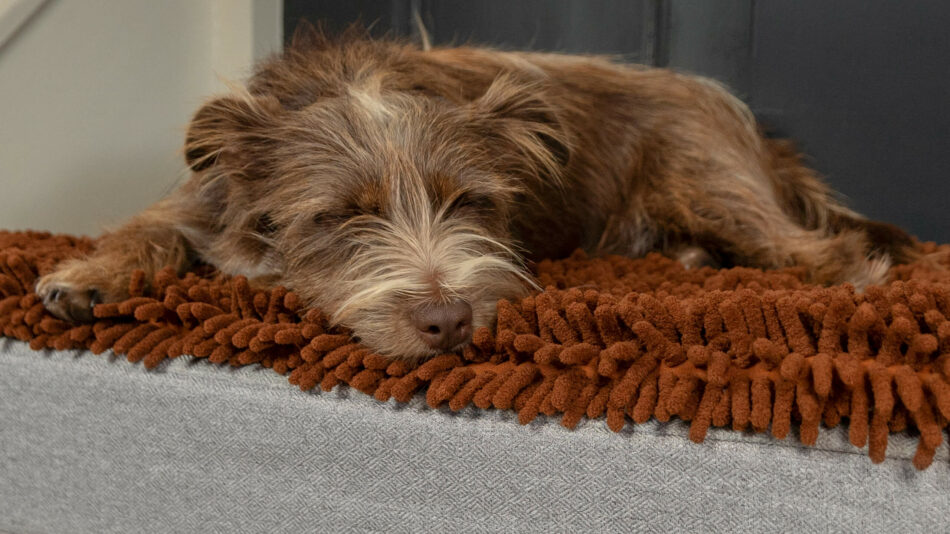

This entry was posted in Uncategorised
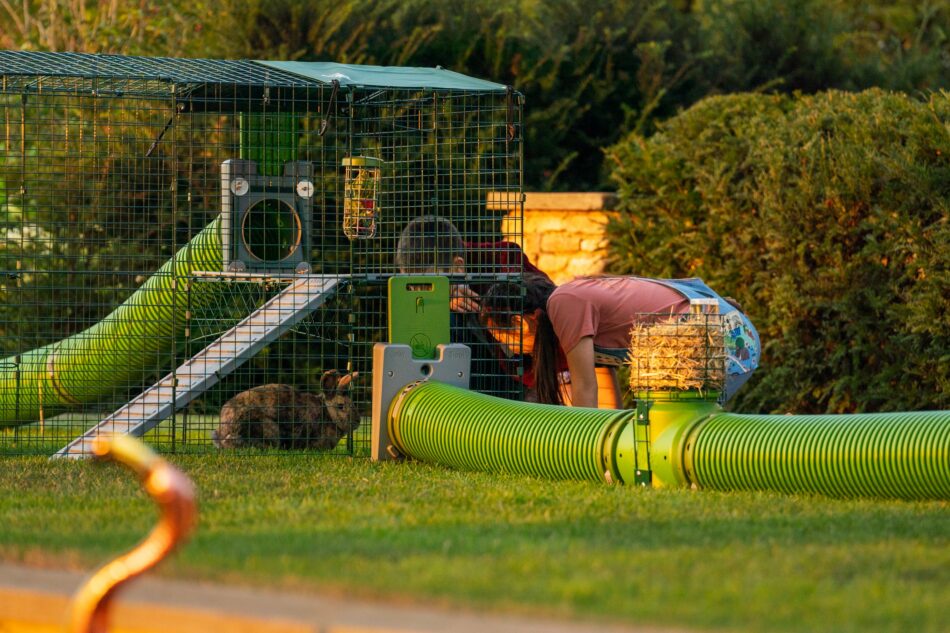
Rabbits are very curious, energetic, and social animals that thrive off of enrichment. For rabbits, enrichment comes from activities that challenge their physical abilities and appeal to their intellectual side. Fostering your rabbits’ natural behaviors and offering their minds and bodies ways to become more strong and agile are among some of the most important aspects of caring for them. We’ve outlined what this means for bunnies, and how owners can provide this type of stimuli for their pets in our rabbit enrichment 101.
Why is rabbit enrichment important?
In the wild, rabbits are constantly on high alert, looking for potential threats, future meals, and gauging weather conditions. These actions take a lot of energy – and as a result, their metabolisms are very fast. Domesticated rabbits however have caring owners that keep them protected from predators, provide their next meal, and keep them sheltered from the elements. But, these natural behaviors are still ingrained in your pet rabbits, and their resulting metabolisms and energy stores remain heightened.
A happy rabbit is an active rabbit, and to foster these behaviors and expel pent-up energy, pet rabbits need enrichment. Bunnies that don’t have engaging activities, toys, or environments can become bored – which can spell trouble quickly.
Types of rabbit enrichment
There are many ways to provide enrichment for your rabbits. From simple changes to their environment to interacting with them frequently and with toys and treats, here are ways you can enhance your rabbits’ daily activities.
Your rabbits’ enclosure
All rabbits should have a spacious rabbit hutch and run large enough for them to run and jump, and tall enough for them to stand up on their hind legs. This factor alone can cause bunnies to become bored if they’re unable to stretch their muscles the way nature intended.
Additional space can be provided with Zippi Rabbit Runs and Playpens to give your rabbits plenty of room to express their natural behaviors. Link your bunnies’ hutch and run to their playpen with Zippi Rabbit Tunnels to provide them with a system that mimics burrows in the wild. Your rabbits will love the feel of tunneling, and you’ll love the damage-free way of letting them borrow and scurry in a way that makes them feel at one with nature.
Rabbit platforms
Another way to add space and variety to their run is to use platforms with your rabbits.
Zippi Rabbit Platforms bring your bunnies up to your level to interact with you and give them a new vantage point. The space beneath the platforms gives your rabbits extra room, and a shady shelter in the summer months. Create a hideout under the platform for chillier weather, or for rabbits that like a secluded space to unwind after a day of running their tunnels.
Rabbit run accessories
Adding accessories to your rabbits’ run adds both visual appeal and excitement to their area. Play tunnels give your bunnies a place to burrow inside of their run. And, when linked with a Zippi Rabbit Shelter, your rabbits can have a modern model of bunny burrows in the wild. The solid structure mimics a warren that wild rabbits retreat to for rest and safety, and the connected tunnels enable your bunnies to feel safe when accessing their hideaway.
Rabbit toys
Toys are another way to enrich your rabbits’ surroundings. It may take some trial and error to figure out which toys your rabbits prefer – some bunnies like auditory feedback during play that toys with bells provide, while others may enjoy quiet toys that they can carry around.
Balls with or without bells (like those for cats), rabbit chew toys, snuffle mats, or puzzle toys are favorites among rabbits. DIY toys made from paper towel rolls or oatmeal containers are also entertaining and simple to make.
If your rabbits aren’t interested in playing with individual toys, try making a digging box for them. Add shredded paper or sand to a container large enough for your rabbit to hop into. All bunnies love to dig, so those who aren’t as interested in playing with toys will enjoy a good rummage through their box.
Treat holders
Elevating your rabbits’ snacktime gives them a fresh perspective along with a nutritional boost. Serving fresh greens and bunny-friendly fruits and veggies in a Caddi Rabbit Treat Holder is stimulating for both their minds and bodies. Adjust the height of the Caddi to accommodate the size of your rabbits, or to encourage them to stretch their legs to reach their treats. By offering special treats this way, you’ll encourage them to use their natural instincts – just as wild rabbits would to reach berries or other rare finds.
Affection
Rabbits also thrive on affection from their humans as a form of enrichment. Getting to know your bunnies’ love language will help you both bond through quality time and displays of affection. Some rabbits are cuddlers, while others prefer being petted or scratched while they take a luxurious stretch. Find what makes your rabbits most relaxed and meet them there. In return, you’ll notice your bunnies displaying behaviors and sounds to show their affection for you.
Omlet and your rabbits
Our ingenious designs are crafted to bring you and your bunnies closer together. Not only are the Eglu Go Rabbit Hutch and Zippi Rabbit Runs and Playpens the ideal home for your rabbits, but their low-maintenance design makes it easier than ever to enjoy taking care of your pets. And, when you add Zippi Rabbit Platforms to elevate your bunnies’ space, you’ll bring them to your level. Experience the enrichment that rabbits can offer their owners when you enrich their lives with Omlet.

This entry was posted in Uncategorised
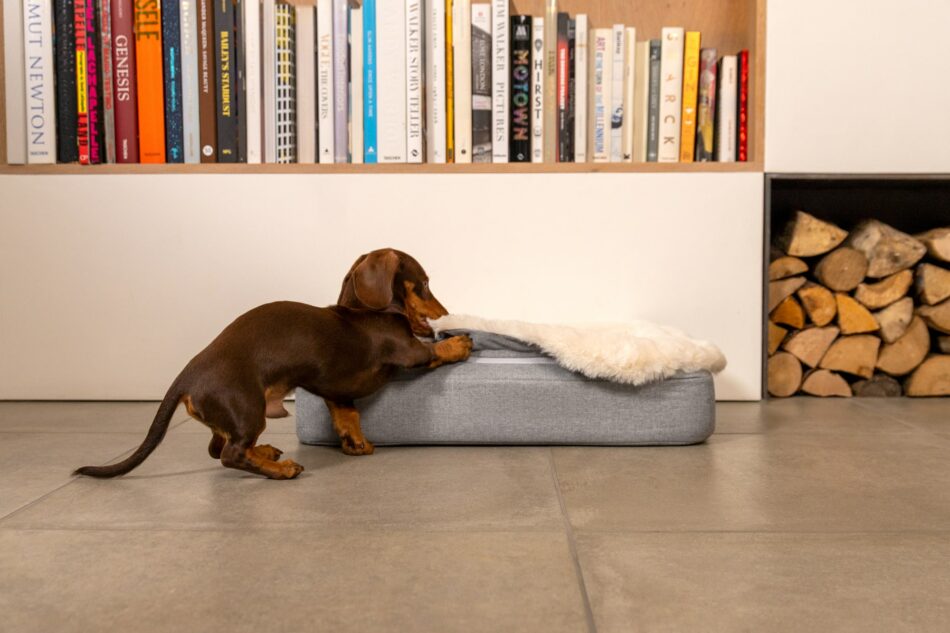
When it comes to your furry friends, we believe they deserve nothing but the best. This is why we created the Topology dog bed – a revolutionary pet bedding solution that has already changed the way pet parents care for their four-legged companion. The Topology dog bed isn’t just an ordinary dog bed – it’s a commitment to comfort and versatility that will last a lifetime. Crafted with precision and love, our unique interchangeable toppers allow you to tailor your dog’s sleeping experience to match the ever-changing weather and seasons. So as winter is fading into a new season, let us help you decide which Topology topper you should get for spring.
How does the Topology dog bed work?
Quality and longevity are at the heart of our design philosophy with the Topology dog bed. Built to withstand the rigours of your dog’s life, our exclusive memory foam mattress base provides a supportive and dreamy sleep that moulds to your dog’s body and creates unparalleled comfort. But our designers went even further in perfecting the ultimate dog bed. In order to perfect comfort, we created a dog bed that would look great in homes as well by not compromising on style.
Say goodbye to constantly replacing your dog’s bed as the seasons shift. With the Topology dog bed, you can effortlessly switch between our wide range of topper options all year long to give your dog, and your home, that new fresh feel. Our range of toppers provides the perfect balance of comfort, temperature regulation, and durability, ensuring your pup stays content and relaxed year-round.
We also thought beyond the confines of the ordinary dog bed to create custom options that allow you to raise your dog’s comfort – literally. The exclusive Omlet dog bed feet are designed to bring new heights of style and relaxation to your dog’s sleep while simultaneously increasing airflow, eliminating dust build-up, and creating a healthier sleeping environment. The Topology dog bed is more than just a place for your dog to sleep – it’s a custom-created sleep environment that’ll always make them feel at home.
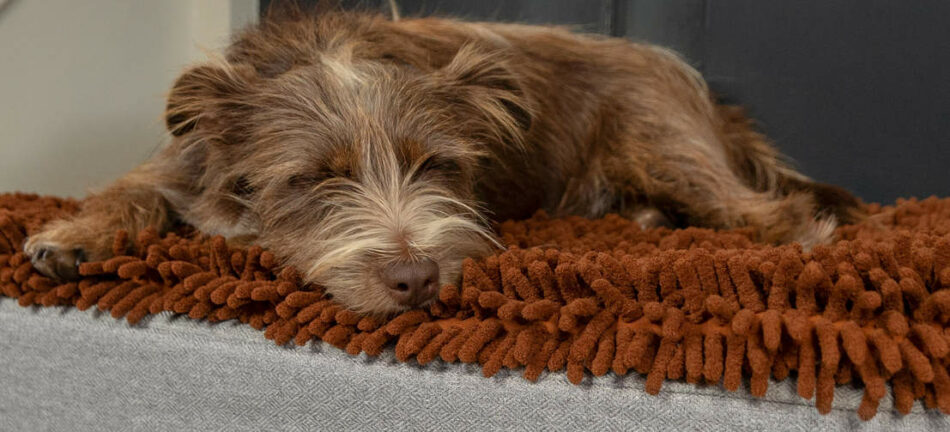
Which Topology topper is best for spring?
As the chilly air turns warmer, we welcome the changing of weather into spring. But how do you make sure your dog starts off the season right? The Topology dog bed is a springtime essential for any dog and choosing the right topper means considering their comfort, needs, and preferences that accompany this new weather.
Beanbag Topology topper
The Topology Beanbag topper is a plush, yet hard-wearing, topper that’s the perfect spring companion for your dog. Constructed with unparalleled comfort, this topper mimics the softness and warmth of a bean bag chair. Opt for the crisp yellow shade, and this colour will add beauty to your interior spring decor, making this the perfect choice for a new season and new dog bed topper.
Microfiber Topology topper
When spring brings rain and dampness, your dog deserves a comfortable and dry place to rest. The Microfibre Topology topper is the perfect option with its fast-absorbing material that easily soaks up water and mud from damp fur and paws that accompany sunny springtime walks. There’s no more soggy bedding with this quick-drying topper, that keeps your dog will keep comfortable in no time. And just like every Topology dog bed topper, the Microfiber topper is easy to remove and toss in the washing machine for hassle-free dog bed cleaning and care.
Sheepskin Topology topper
The Sheepskin Topology topper is the ultimate choice to keep your dog cosy and comfortable this season with its luxurious softness and insulating warmth for the early and chillier days of spring. Create a welcoming haven for your furry friend with this topper that allows them to curl up in a peaceful slumber. Beyond its functionality, the Sheepskin topper adds an element of sophistication to your dog’s domain. Choose from three different sizes and multiple shades to complement your home decor.
Omlet and your dog’s bed
This spring, Omlet is your one-stop destination for ensuring your dog stays comfortable, and cool, whilst staying cosy as we transition into a new season. Start your dog’s season off right with the Topology dog bed which is the heart of our collection. Next, choose a versatile Topology topper from our wide range of styles and colours to match your dog’s specific level of comfort and needs. Add a Luxury dog blanket to go on top and – voila – you just created the ultimate spring-ready doggy comfort zone. All that’s left to do is enjoy the new season with your favourite pup.

This entry was posted in Uncategorised
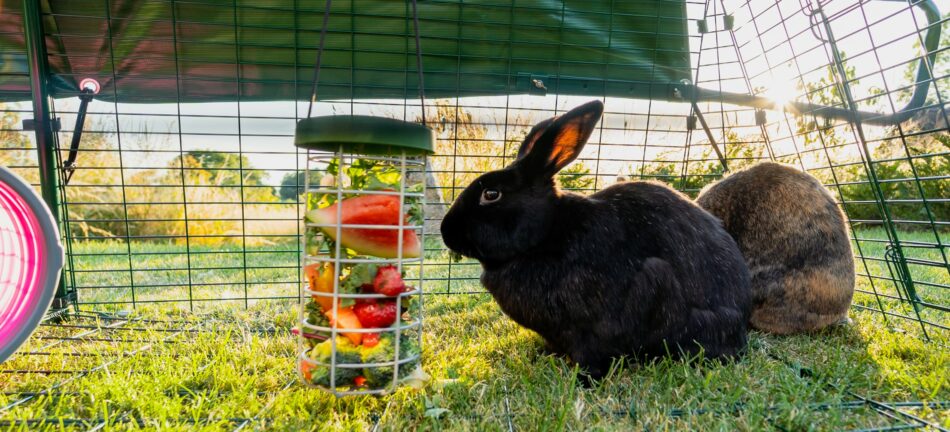
Did you know that rabbits moult twice a year? If you notice your bunny losing a lot of fur during the spring and autumn, it’s likely due to this seasonal shedding cycle. But caring for your rabbits through a moult doesn’t have to be difficult — we’ll share our top tips for keeping your bunny comfortable when the fur flies.
Why do rabbits moult?
When you find fur all over your rabbits’ run, or notice them looking shaggy or unkept all of a sudden, you’re likely witnessing one of their moulting cycles. Rabbits will moult twice a year — once in the spring, and once in the autumn. This natural process is triggered by the amount of sunlight and the temperature of where your rabbit is kept. Your rabbit will moult:
- In the spring to shed their thick winter coat in preparation for warmer weather
- In autumn to grow a thicker, heavier coat for winter
- As babies to grow their adult coat
- As a result of stress or illness
The entire moulting process takes between 2-6 weeks. Rabbits that complete their moult in 2 weeks will lose hair rapidly, leaving large amounts of fur behind. Those that take the full 6 weeks will shed their fur more slowly, so you won’t be as likely to notice the change.
You may also notice your rabbits being slightly more irritable during the moulting process. They may also scratch, bite, lick, or rub at their coat in an effort to remove loose hair. Your rabbits may not want to be held during their moulting cycle, as their skin will be sensitive while growing a new coat.
Care tips for your rabbits’ moult
There are a few things you can do to help your rabbits through their moulting cycles. By helping them shed as efficiently as possible, you’ll be able to get back to your favourite bunny-bonding activities.
Housing and exercise
As part of the essentials needed to care for rabbits, your bunnies’ home should be clean and accommodating. It helps to have an easy-to-clean rabbit hutch — especially during moulting seasons. Excess hair in your rabbits’ hutch or run can attract insects and accumulate unwanted debris, so it’s important to remove it as often as possible.

Grooming
Brushing your bunnies can help them shed their coat faster. The buildup of fur in the process of shedding can create painful mats or restrict your rabbits’ natural insulation methods. Using brushes designed to loosen undercoat fur will help prevent matting, and help keep them comfortable. Removing loose hair also helps prevent your rabbits from ingesting too much fur through self-grooming.
If your bunny doesn’t enjoy being brushed, you can also gently pull the displaced tufts of fur from their undercoat. Only attempt to pull on tufts that are obviously extended beyond the length of their top coat — otherwise, you may risk pulling hairs that are still attached.
Diet
Your rabbits should always have access to fresh, clean water, timothy hay, and quality pellets — especially during moulting seasons. Growing a new hair coat takes a lot of energy, so be sure you’re giving your bunnies everything they need to fuel their bodies. Offer healthy treats like fresh leafy greens in a Caddi Rabbit Treat Holder to give their immune systems a boost during their moult.
Abnormal rabbit shedding
Healthy outdoor rabbits will moult in spring and summer, with minimal shedding in between in order to maintain a healthy coat. Indoor rabbits that aren’t exposed to as much natural light or fluctuating temperatures may gradually shed their coats throughout the year, giving the impression that they shed year-round.
If you notice your rabbits losing an excessive amount of fur outside of autumn or spring, or see inflamed patches of skin during a moult, you’ll need to contact your veterinarian. Rabbits can lose or pull their fur for other reasons, like:
- Illness or skin infections
- Stress
- Pregnant females preparing a nest to have their litter
- Fighting
- Unsanitary living conditions
Provide your rabbits with consistency throughout the year to keep their stress levels low. Avoid keeping intact males together to prevent aggressive behaviours, and keep intact males and females separated to prevent unwanted litters. Monitor new rabbits closely to see if cagemates become stressed, and try to avoid frequent changes to their diet. And, always keep your rabbits in a secure, comfortable home like the Eglu Go rabbit hutch to help them feel safe in their surroundings.
Omlet and your rabbits’ moult
If you’re thinking of upgrading your rabbits’ run this spring to help them through their seasonal moult, it’s never been a better time to transition them to the ingenuously designed Eglu Go rabbit hutch. Warm in the winter and cool in the summer, pair the Eglu Go rabbit hutch with other rabbit essentials for full fur-shedding support all year round.
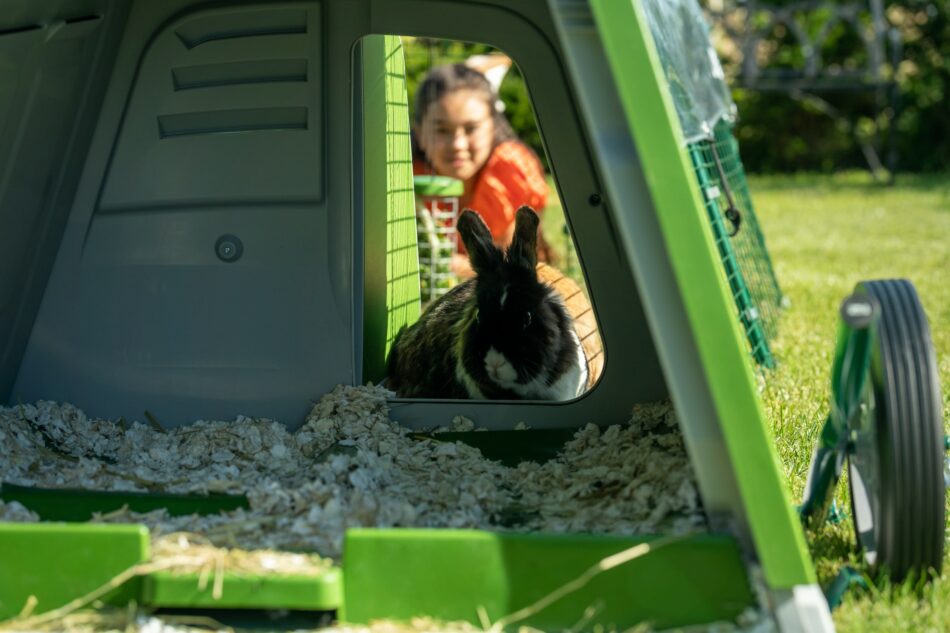
This entry was posted in Uncategorised

Whether your cat is moving with you to a new house or you’re welcoming a new cat into your life, a new home can be stressful and confusing for our feline friends. The first few days are especially trying, and it’s important that you as an owner do everything you can to make the move as smooth as possible for your pet. Read on to find out some top tips for moving with cats.
Moving to a new place with a cat – before the move
If you are moving with a cat, try to keep the cat’s routine as normal as possible in the days leading up to the move. Very anxious and timid cats will benefit from familiarizing themselves with cardboard boxes around the house before you start packing your belongings.
In the new house (or your current home if you’re rescuing a cat), prepare a room somewhere where you can keep your cat when you arrive. This should ideally be a spare room or a bathroom away from the hustle and bustle of the home. Cats will naturally think a new house is scary and smells unfamiliar, so giving them a smaller space to get familiarized with to start with can be less difficult.
Give your cat places to hide in the room, as well as a snug spot to relax, maybe with something they already feel comfortable with, like their super comfy donut cat bed or a blanket from the rescue centre. Also prepare a cat litter box, bowls with food and water, and some toys.
A Freestyle cat scratching tree that is tall and rigid will also help your cat let off some steam and allow them to leave familiar scents from glands in their paws, which will help them keep calm.
If possible, prepare this room with everything your cat needs before bringing them home.
During the move
The most important thing when getting a cat to settle in a new environment is to have patience and always let your cat make the first move when it comes to approaching new things, or new people. Most cats love feeling in control, and by pulling them out of the cat carrier or picking them up for a cuddle you could be adding to your cat’s stress.
Be aware that it might be a few weeks, or even months, before your cat feels comfortable in their new home. It takes them time to get used to new surroundings, not to mention other cats or children they’ve never encountered before.
If possible, it’s good to give your pets something familiar that makes them feel safe. If you’re adopting a cat, ask the adoption centre if they have a blanket or toy your new addition has been using, or if you’re moving house with your resident cat, unpack their things first. Don’t change the food you’re giving them, give them a new litter tray or treat them to a new bed just yet.
How to introduce cat to new home
Make sure the space where your cat is allowed to be is completely cat proof. This might, to start with, just be one room, but if you’re letting your feline friend explore the whole house, keep all doors and windows closed, and check potential cat flaps or even chimneys before you invite your cat in. Give everyone around on moving day careful instructions or put a sign on doors to inform them where the cat is. The new home will seem like an unsafe space for your pet, and their instinct will most likely be to escape.
Once you have set up a room or an area for your cat to initially settle into, carry the cat into the room and open the door to the cat carrier. Sit back and see what they are doing, but never force them to come out or pick them up, let them explore in their own time. You can sit in the room, or you can leave for a bit and come back later.
When you have seen that your cat is comfortable in their room you can open the door and allow them to come into the rest of the house whenever they feel ready. Cats are naturally inquisitive, so they will want to explore their new surroundings.
If you have other animals or pets in the house that your new cat has not met before, make careful introductions i.e. initially using a barrier, keeping a distance. You should try to space out any stressful events to not overwhelm your cat.
It’s normal for a new cat, or a cat in a new home, to not have much of an appetite or to cry during the first few nights. Unless you think it might be detrimental to your cat’s health, or that they are in danger, leave them to it. Most cats will stop this behaviour after a couple of days.
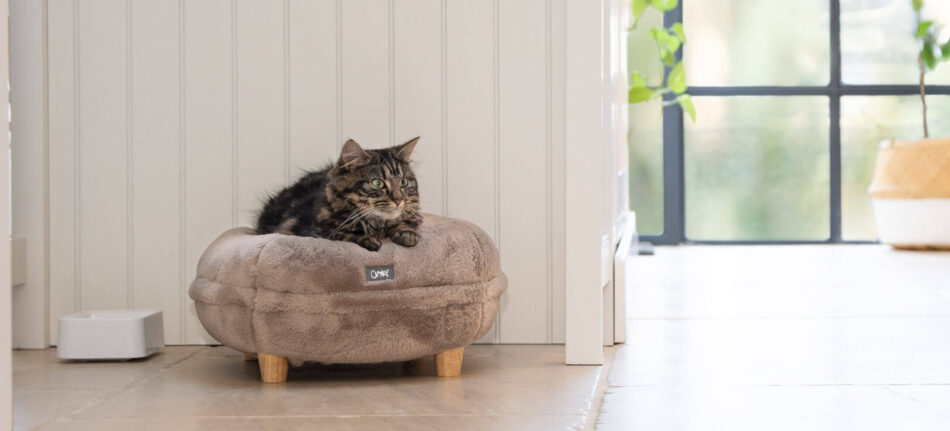
Transporting your cat to a new home
Make sure you have a good pet carrier that is big enough for your cat. If you can, it’s a good idea to get your cat used to car rides before the journey to a new home, but that is obviously more difficult if you’re picking up a rescue cat.
Put some soft bedding in the carrier and secure it in the trunk or with a seat belt inside the car. It’s important that it’s safe and doesn’t move around, as that will be very stressful for your cat. Regulate the temperature in the car so it’s cool but not cold.
Keep the journey as short as possible; don’t make any unnecessary detours or make stops you don’t have to make. If you do need to stop, it’s often best not to let the cat out of the carrier, as there is a risk they will escape. However, never leave your cat unattended in the car. It can quickly get dangerously hot, fast.
Moving a long distance with cats
If the journey is so long that you will need to stop and allow your cat to go to the toilet or eat and drink, it’s important you find a place where it’s safe to do so. Consider keeping your cat on a lead, or only let them out in a confined space. If you’re travelling really far you might want to sedate your cat to make the journey less stressful for all. Speak to your vet to see if this is an option.
When to let your cat outside
If you have a cat that normally spends a lot of time outdoors, you might want to let them out as soon as possible and give them their freedom back, but it’s generally good to keep a cat indoors for at least a few weeks. Moving is one of the most common reasons cats disappear, be it because they don’t feel safe in their new house or that they get lost, so be careful. You can read more about this in our previous blog post Why Do Cats Run Away?
Moving house with an outdoor cat
While keeping outdoor cats indoors, make sure they have plenty of stimulation and exercise opportunities.
Once you think your cat is ready to go outside, one thing you can do in preparation is to sprinkle a bit of used litter around the perimeter of the yard. This will make the outside space smell familiar to your cat, and other cats in the neighbourhood will be warned that there is a new cat on the block.
The first times you let your cat out, make it short, and keep an eye on them. Call them back after a few minutes, and gradually extend the time they spend in and around the yard. It’s best to stay with them to reassure them that everything is fine, and leave the door or cat flap open so they can return into the house if something scares them.
If you have moved somewhere that doesn’t allow your cat to roam as freely as they have previously done, be it due to traffic, wildlife or neighbours, you might want to consider investing in an Outdoor Cat Run. Omlet’s catios lets your cat feel the wind in their fur in complete safety, and they can keep your cat healthy and fit without the worry of them running away or getting hurt.
Moving house with your cat
While lots of these tips apply to a new cat as well as a long term pet who is moving with you, there are some specific things that could help a current cat settle in.
As your cat has been living with you, there are things that will be easier than bringing home a new cat. Maybe they have a Memory Foam Bolster Cat Bed where they can go for some quiet time and that will immediately make them feel at home. If you want to introduce your cat to a cat house, this might be a good time, as they will be searching for a safe space to retreat to.
Depending on their personality, you will probably want to let them out of their initial introduction room quite quickly. They are used to being around you and your family and keeping them separate can be more stressful. But again, wait for them to make the move.
One thing to help your cat adjust can be to take a piece of cloth and rub it gently around your cat’s neck and face to pick up their scent. You can then wipe this cloth on furniture in the house at cat height to make the new territory seem more familiar. Feliway products or a pheromone diffuser can also be good options.
Remember to update the address on their collar and change their microchip information on any database.
If you haven’t moved far, there is always the worry that your cat may disappear in search of their old home. Sometimes the new owners will provide food and leave out water bowls for the unexpected visitor, so, if possible, ask the new residents to let you know if your cat shows up. To avoid these trips down memory lane, keep your cat indoors for the first few weeks after the move. That won’t necessarily make them forget their old home, but should get them used to their new one, and hopefully realize that’s where they belong.
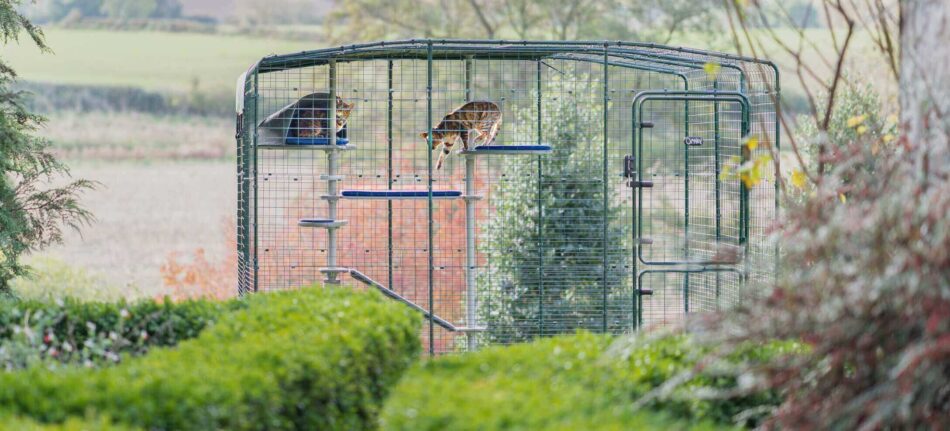
Moving with multiple cats
If you live in a multi-cat household, then this can inevitably make things a little bit complicated, but with the right preparations, the move can be made as stress free as possible! The process of moving itself isn’t all too different, but you will have to consider the needs of more than just one animal. Take a read of our How to Create Peace in a Multi Cat Household blog for some advice on creating a better dynamic between your cats, which will help in making the transition easier when the time comes.
Conclusion
A move is a very exciting event for both cats and humans, especially for those who are moving from a shelter to their forever home. However, most animals are creatures of habit, and many cats find a new house a very scary thing. To make the move a bit more comfortable, shop Omlet Cat Products to help you find everything your purry pal needs to settle into their new home. Make sure you prepare yourself for the next few days, or weeks, to be a bit tiring. And with these tips for moving with a cat, it will, of course, be worth it in the end!
This entry was posted in Uncategorised

If you have ever raised a child from baby to adult, you know all too well the joys, headaches, tribulations, and rewards that come with that experience. But what about raising a four-legged baby? You know, the kind that has fur, a wagging tail, and slobbery kisses for days. Is raising a dog the same as raising a human? Our fur babies may not be able to communicate what they want as well as human babies, but that doesn’t make them any less a member of the family. To build and maintain an everlasting bond with our dogs, it is essential that we understand their needs in every stage of life.
As discovered in our previous blog, How Old Is Your Dog In Human Years, our canine companions age much faster than their human brothers and sisters. A poignant reminder that every moment counts and each cuddle could last a little longer. So how long is a dog considered a baby? When do you know if your pup has officially entered the scary, yet delightful, teenage years? And how can we better support our senior pups in their prime as they slow down? Here is a helpful list to guide you and your dog through these precious stages together.
Puppyhood
The cuteness overload puppy years! This is the time when your fur baby still has that intoxicating puppy smell and abounding energy. Depending on the dog breed, this stage of a dog’s life is usually between birth and 18-24 months. Just like humans, this early phase of development is where your dog will learn basic socialisation skills. You want your fur baby to be a part of the family, right?
There are several different ways to engage your energetic and curious puppy. Spend lots of time during this stage talking to them, petting them, and teaching them all the rules like potty outside, sleep through the night, and don’t chew on the furniture. Your pup will also grow the most during this stage of life, so good quality nutrition and veterinary care are also essential in making sure fido flourishes. Puppies can be a lot of work, but with consistent routines and training, you will have a teenager (eek!) before you know it!
Adolescent to Adult
What’s that? No exhausting toddler years to navigate with dogs? That’s right! Most pups will reach “adulthood” by the age of 3, which means the adolescent teenage years are short depending on the dog breed. Smaller breed dogs, such as Chihuahuas and Dachshunds, become teenagers around 6 months old, while larger breed dogs, such German Shepherds and Great Danes, become adolescents around 3 years of age. While most of the obedience training occurs during the puppy years, you want to continue positively reinforcing good behaviour at this stage. Adolescent dogs are a lot like adolescent humans – they will start to test the boundaries around this age. Just when you thought you mastered the “sit, stay, shake” commands, your adolescent to adult dog will start to challenge you by ignoring these learned behaviours, so don’t fall asleep at the wheel, or leash.
Mental stimulation is also important across all developmental stages, so keep your teenager pup engaged with lots of activities like fetch, doggie play dates, and games. The key to this stage? A tired dog is a well-behaved dog! And don’t forget your dog’s health and hygiene which is important regardless of age. Most healthy adult dogs still need consistent exercise and, depending on dog breed and temperament, that could be up to 25 mins a day. So make it a family affair – grab both your teenage human and teenage dog and get everyone out on a walk!
Prime Senior
Just because your fur baby is now a fur senior doesn’t mean you have to start looking into retirement homes for your canine companion. Older dogs are still active dogs! If you have had your fur baby since puppyhood, you may start to notice your now white-muzzled pup slowing down the pace a bit around age 6. Perhaps you notice yourself slowing down a bit as well to mirror their behaviour and better care for their changing needs. That’s a good thing! Instead of one long walk each day, consider taking your senior on a few short walks to maintain exercise without exhaustion. You may find you like this new change of pace as well!
Many prime senior pups will also start to change behaviours at this stage with some mobility and cognitive changes, so it is important to keep up with regular vet care visits to monitor any significant issues. Can’t teach old dogs new tricks? Nonsense! Older dogs can absolutely learn new tricks, but just like senior humans, keep the food rewards to a minimum as metabolism starts to slow down in this stage. In addition, some older dogs may begin to have joint problems around this stage, so ensuring you have a comfortable and supportive dog bed is critical. The Omlet Topology Luxury Dog Bed is a great option to customise a sleeping solution fit for a king, or queen, senior. Regardless of dog breed, older dogs of all shapes and sizes are still as enjoyable and lovable as puppies!
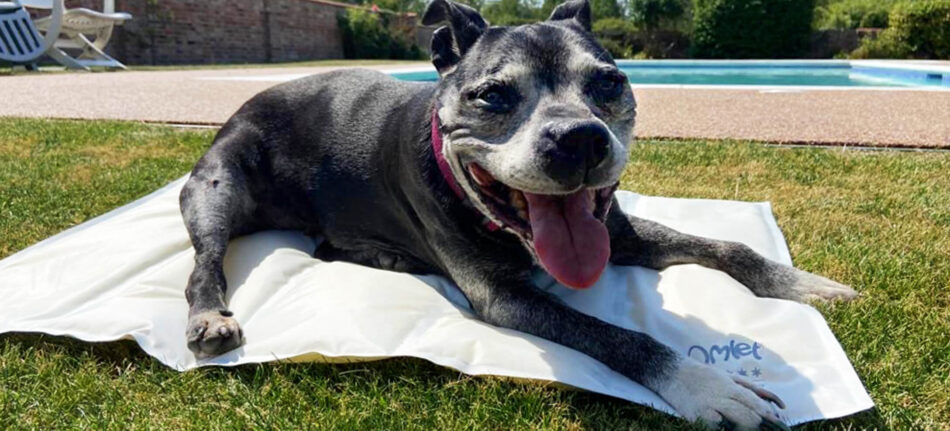
Pet owners know that taking care of a dog, at any stage of life, is a commitment full of work and reward. Whether you have a bouncing puppy that is still learning how to walk on a leash or a prime senior who loves to just lay in the sun, there is much to be gained from every stage of a canine’s life. And even though our fur babies are not around as long as our human babies, it goes without saying that the love they give is invaluable no matter what age. So enjoy every moment of every stage!
This entry was posted in Uncategorised
Amy Wolsey lives in Norfolk with her 11 happy hens. She’s kept busy with 6 Cream legbars and 5 Pekin Bantams. They, like her Springer Spaniel Oliver, love to help her in her garden and vegetable patch! Follow Amy on her Instagram account chicksandveg.
My garden just wouldn’t be the same without my chickens. As I potter round, their chatter keeps me company and there is something so joyful about seeing them have a dust bath under the hedges or weed my paths! My chickens love helping me out in the vegetable patch but if I left them too it, I wouldn’t have many veg left! So I’ve tried to design my garden in a way that allows all of us to enjoy it.
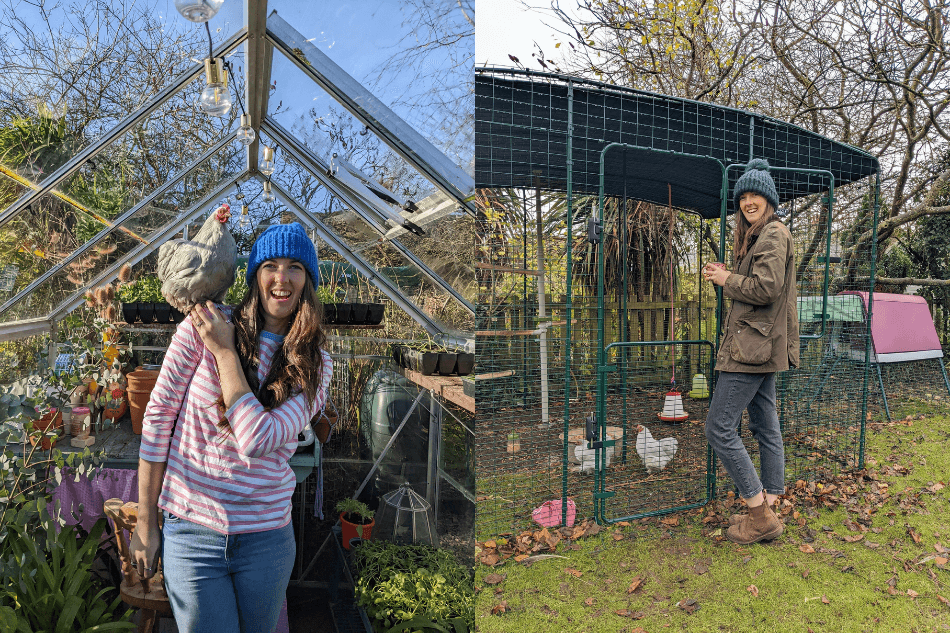
Setting up your space
It’s a good idea to have the ability to move your chickens around the garden and shut off areas you don’t want them exploring. I’ve divided my garden into areas, some the chickens are free to explore and others are kept gated. This isn’t possible in every garden but the same can be done using temporary fencing. I’ve used chicken fencing and even expandable trellis to section off areas. It’s a good idea to move your chickens around, giving areas of your garden or lawn a breather and it keeps your chickens busy exploring new spaces.
Despite being mostly able to range freely in my patch, I do have a safe and secure home for them in the form of their Walk in Chicken Run from Omlet. It’s got plenty of room, treats and perches to keep them occupied, and it provides a great space to shut them away if required.
I use raised beds in my vegetable patch which go someway to stopping my hens nibbling my vegetables but if you want to guarantee your chickens can’t access your precious veg you could look at using tunnels or netting to cover them. I have hoops and netting over some of my seedlings to keep pests out but they also help to keep hungry chickens at bay too!
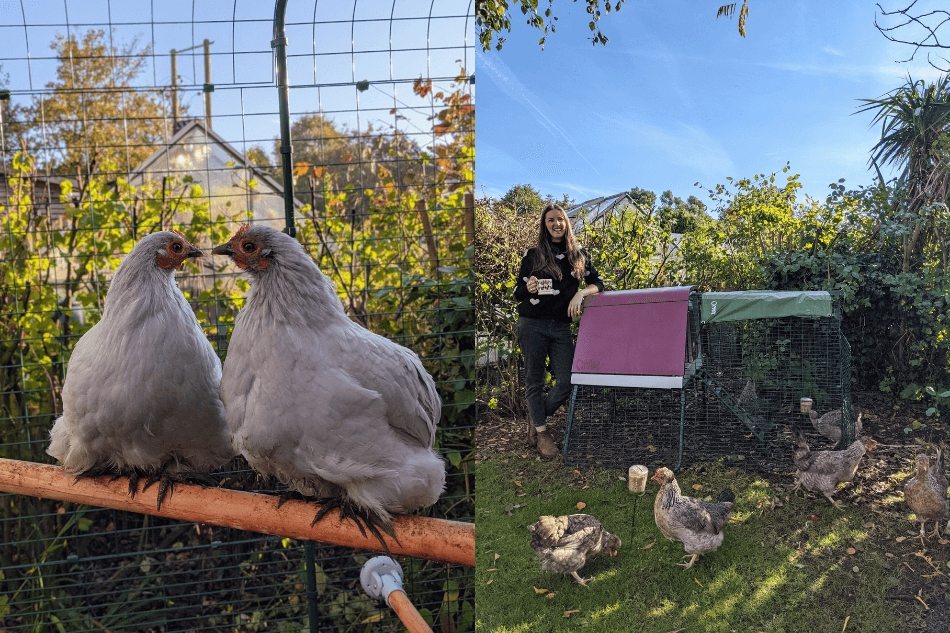
Growing for chickens
Don’t get me wrong, whilst I like to make sure my chickens don’t help themselves to everything I’m growing, I do like to treat them every so often! I grow lots of ‘extra’ veg throughout the season and my hens are great at tidying up any plants that are looking past their best.
My favourite thing to grow for my chickens are speedy salads and super quick microgreens. I have a few pots that I dedicate to sowing and growing some tasty treats for the hens. Each week I’ll scatter a few seeds in a pot or shallow tray and some of the speediest microgreens can be growing after only a few days. They finish them off in a few minutes but their happy chirps are so worth it!
Another speedy crop that doesn’t take up too much space is radish! Plus if you want to keep the root yourself they love the leaves on their own! Speaking of leaves you’ll often find me pulling off and sharing the outer leaves of brassicas and lettuce with my hens. The love chard too which is handy as it thrives in my garden and I’m often overrun!
I don’t just grow vegetables for my hens! They are big fans of sunflowers (aren’t we all). So once they’ve finished blooming, as well as leaving some for the garden birds, the chickens love nothing more than pecking out all of the seeds. Nasturtiums are another beautiful bloom which I love to have dotted round my garden, they grow well in hanging baskets and draped over the edge of beds. Perfectly placed for hungry chickens and they distract them from my vegetables!
Chickens bring so many benefits to the garden. They are great at pest control for slugs and other critters, they provide manure which when broken down properly can act as a brilliant fertiliser and most of all, they are great company! I’ll always share my garden with my chickens and I want to make sure they enjoy it as much as I do!
This entry was posted in Chickens
Miriam Drennan grew up on an organic farm with chickens, guineas, quail, cows, ponies, dogs, and any number of cats. She now lives in an urban neighbourhood in Nashville, Tennessee, and works as a freelance writer. She has had her current flock of hens for about two years. Even in an urban setting, she retains the practices her father taught her regarding how to care for the soil, plants, and creatures responsibly. It’s worth mentioning that her two rescue dogs, Anchor and Chance, are not much help around the house, and simply coast through life on their looks and charm. Miriam is also an enthusiastic Omlet ambassador, so if you happen to pass by Tennessee and are interested in any of the products she has – get in contact!
“What’s it like, raising urban chickens?”
I get this question a lot, once people learn that I have hens in my backyard, three miles from downtown Nashville, Tennessee. Thanks to the Omlet system, it’s quite easy.
My set-up is simple and stylish—the Eglu Go Up Chicken Coop and its adjacent Walk In Chicken Run are surrounded by the Omlet chicken fencing. No running water or electricity, but I have found a few hacks when the weather gets extreme.
So—what is it like, raising urban chickens? The timeline will shed a little light on what an average day might look like for me.
7:15 a.m. The sun is just beginning to stir, but not fully awake, which is a good time to refill the feeder with fresh food and replace the water in the drinker. It’s easier to do this before turning them out; I can leave the gate open and wander in and out freely, which comes in handy when you are lugging heavy containers and bags. My girls eat organic food, sprinkled with some herbal supplements to keep their yolks bright yellow and their immune systems healthy.
7:30 a.m. This will be a big morning for them, because they are getting their Free Standing Chicken Perch! Where to place it? Finally, I find a spot and insert the stakes—the rain we had recently helps them go in easy, then I add some dried mealworms to the treat tray that attaches to it.

7:45 a.m. It’s still a bit chilly this morning, so I add another layer of straw on the floor of their yard. They have scratched it bare, which is what chickens do, and the straw keeps their feet from getting too cold. In the summer, I switch to shredded pine mulch.
7:55 a.m. Next, I sprinkle their yard with grit and oyster shell for their gizzards and calcium intake, respectively. Chickens enjoy scratching for treasures, so it doesn’t matter if I leave these in small bowls or sprinkle throughout their yard.
By now, the girls are stirring—they know I’m there, and they’re ready to get out and play. Time to turn the crank . . . and out they come, like big feathered cannonballs shot out of a cannon (who needs steps when you have feathers?). As they fluff and flap, let me introduce them:
- Zuzu: A White Leghorn who looks brown because she likes to drink from mudpuddles. Although Zuzu is the smallest, she is the queen of the flock.
- Daisy: An Easter Egger and friendly, she is the largest in the crew.
- Dixie: An Olive Egger and shy; Dixie is a beautiful bluish-grey hen and her feathers are outlined in darker grey.
- Beaker: A Speckled Sussex and a bit of a rebel. Beaker’s finally getting tiny pops of brilliant green, purple, and blue feathers after this last molting.
8:10 a.m. As expected, Zuzu is the first to approach the perch tree, cocking her head a bit. She realizes this new “thing” in her yard has treats, so she’s good with that. Beaker is next, followed by Daisy. Dixie is shy; she hangs back and eventually, snatches a mealworm and runs back to safety.
I leave them to get acquainted with their new toy.
8:30–9:45 a.m. They sing their egg songs for all the neighborhood to hear. (Thankfully, my neighbors think it’s funny.)
10:00 a.m. Lawn Man has arrived to mow and trim, and as far as the girls are concerned, he is Public Enemy #1. They don’t like his noisy machines and they don’t like him in their yard, even though they are completely enclosed and safe in their Walk-in Run. After running around, trying to figure out where to escape Lawn Man’s motorized beast, they settle for the area underneath their coop. I recently enclosed this section with a few Omlet Heavy Duty Tarps as another place they can use for privacy. They love it. It’s a great little space for dust baths, running from the Scary Evil Snow that falls, or just to gather and cluck. Only Zuzu dares to walk out and challenge Lawn Man, who tips his hat to her and mows on.
12:00 p.m. I have time between work calls to check for eggs. Happy hens are productive hens, and mine lay fairly consistently all year long. I credit the Eglu Go Up for a lot of this, because its insulation and design help maintain a fairly consistent temperature inside the coop. In the winter, I wrap the coop in Omlet’s Extreme Temperature Blanket, and if the temps dip to single digits, I might stick a hot water bottle inside with them—a bit of overkill, perhaps, because the Eglu’s insulation and the hens own body temperatures keep things quite warm inside. Each of mine lay an egg of a different color, which helps me keep up with who is producing and how often.
When I take a peek, I see that they’ve had a busy morning—all four have produced!
2:30 p.m. It’s warming into a nice spring day, so it’s time to clean the coop. Normally, it might take me 15–20 minutes total to clean, but today, I need to give it a really thorough scrub, so it might take about 30 minutes total. I dump the droppings into my composter and head for the outdoor spigot. A drop of the original Dawn dishwashing detergent makes this easy—the actual scrubbing takes less than 15 minutes. I leave the tray and roosting bar in the sun to dry while I wipe out the coop’s interior, which is easy. Zuzu wanders underneath to supervise, and lets me know whether I’ve missed a spot.
I finish drying the trays by hand and add soft pine shavings for a nest. Sliding the trays back in, I open the coop door again, so that each one can hop up the ladder and critique my work. Zuzu makes a point to tear up the nest within minutes after it’s in place—I’m not sure if that’s a compliment, or if she’s demanding a do-over?
4:30 p.m. My neighbor Lisa texts that she has some spinach for the girls. We place the spinach in their Caddi Treat Holder. Their reaction is priceless; to them, Lisa = Spinach, so they’re always excited to see her. We chat and watch them still figuring out their new perch tree.
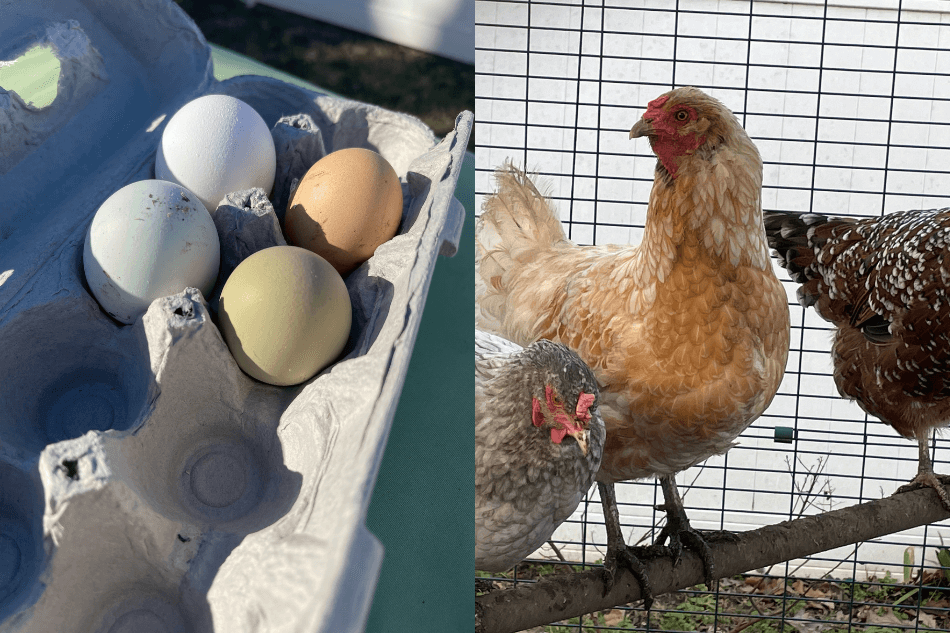
7:30 p.m. The sun is setting; most of the girls have gone up. All but Beaker. Always Beaker. Why does she linger and wander around?
7:32 p.m. Beaker, aren’t you tired?
7:35 p.m. C’mon Beaker, why do you do me this way?
7:42 p.m. She’s going, going . . . nope, false alarm! She’s back in the yard. And now she’s got Dixie with her.
7:50 p.m. Dixie hops back inside the coop. Beaker, why won’t you do the same?
8:08 p.m. Finally, finally, Beaker turns in. I slink back out to the coop, because I know the slightest noise will bring her right back out. I quietly unhook the fence and turn the crank on the coop’s door.
Good night, ladies, I whisper.
I hear a gentle cluck-cluck-cluck as I’m walking away, telling me to sleep well.
Only now am I aware of hushed laughter, a neighbor’s guitar, and a faraway siren to remind me that yes, my chickens are city girls, and thanks to the Omlet system and accessories, they are safe, happy, and healthy.
That’s what it’s like to raise urban chickens.
This entry was posted in Uncategorised
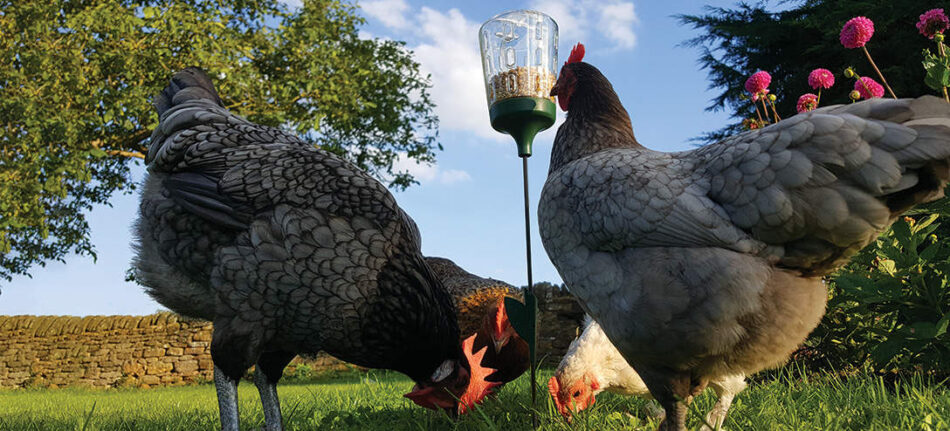
Chickens are not only great companions, but also a great way of being more resourceful, providing you with a frequent supply of fresh eggs. However, you could have a problem on your hands if you begin to notice that a few eggs are going missing. Sometimes chickens develop a bad habit of eating their own eggs, which although is not detrimental to their health, is a sure sign that something is not right.
Your Chickens are Bored
Your poor chickens may simply be suffering from boredom! Boredom in chickens can occur when they either don’t have enough space to roam, or they’re lacking facilities to keep them entertained.
For a happy hen, they need a bare minimum of 1 square meter each in their run, however 2 square meters plus (per hen) is always preferable. Chicken toys are also a fantastic way to keep your chickens entertained. How about trying out the Omlet Pendant Peck Toy, an interactive and engaging feed toy that not only improves flock behaviour but will provide your hens with the mental stimulation they desire.
Dehydration
Chickens that eat their eggs may be dehydrated. Since eggs contain a large amount of water, your chickens may be resorting to eating them simply to keep themselves hydrated.
To stop egg eating behaviour, make sure that your hens are supplied with a clean water bowl/feeder at all times. During the warmer summer months, chickens need a lot more of it, so add some ice to their bowl or feeder to make sure they stay on top of hydration.
Vitamin Deficiency
A vitamin deficiency can be another reason as to why your hens have turned to egg eating. Your chicken’s diet is fundamental to their wellbeing, and a poor one could be depriving them of their nutritional requirements. Along with eating eggs, broken eggs can be another indication that your chicken is vitamin deficient, more specifically suffering with a calcium deficiency.
It’s important to provide your chickens with a balanced diet of enough protein, carbohydrates, vitamins, and minerals, so although they naturally forage, you should supply your chickens with a good quality feed. For added calcium, it’s recommended to add grit, a ground hard substance, to your chicken’s diet, which aids with digestion. Surprisingly, you can feed your hens crushed egg shells, or alternatively, you can use crushed oyster shells – a high calcium, soluble grit.
Inadequate Nesting Facilities
Your nesting box needs to be a secure and safe space for your hens. Egg eating can occur when your hens are uncomfortable with the nesting box, most commonly due to the bedding itself or exposing your chickens to too much light.
First of all, make sure that their nesting area has adequate bedding and is made of a comfortable nesting material. There are a number of choices of bedding to choose for your hens so if you notice that they are not getting on with what you’re currently using, try changing their bedding to see what works best for them. You’ll also want to keep on top of cleaning their bedding by replacing it weekly, also removing any droppings. The Eglu chicken coops make for easy cleaning, with integrated and private nesting boxes, whilst offering plenty of space that your hens will love.
An Anxious or Stressed Chicken
Chickens found to be eating eggs can also be suffering from stress or anxiety, which your hens can be experiencing for a number of reasons. Stress-inducing scenarios can be related to either handling, a new environment, the introduction of new chickens, extreme heat, or regular visits from predators.
Having an anxious hen isn’t pleasant for either you or them but fear not, as there are steps you can take to help minimise stress to help your egg eaters. Some stressful situations are easier to tackle than others, such as introducing new chickens or handling if these are two stressors. Take a look at Omlet’s guide on how to correctly handle your chickens and guide on introducing new chickens for some more help.
Still Struggling?
If you’ve tried all of the above, ruled out anything medical, and yet your flock remain stubborn with their egg eating habit, here’s what else you can do to try and tackle the problem:
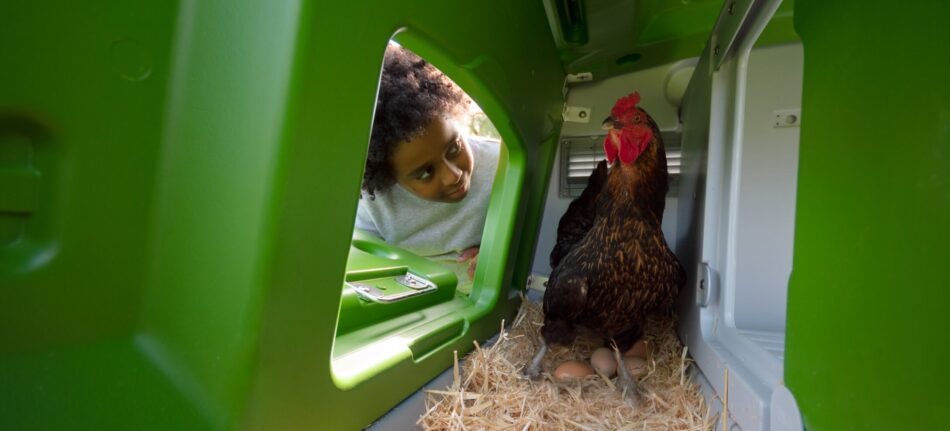
Quickly Collecting Eggs
Quickly collecting eggs once they have been laid will give your chickens, or particular offender if it is just the one hen, less opportunity to eat the eggs. If possible, check the next box four times a day to start with. Hopefully after a few days, this will break the habit, and you can go back to collecting the eggs once a day.
Fake Eggs
Fake eggs can be made of wood, rubber, or ceramics and will leave your chicken pecking but will eventually become frustrated so that they’ll stop attempting to peck at real eggs.
Using Mustard
Create a small hole in your egg, empty the contents and fill with mustard. Mustard is a flavour that (most!) hens can’t stand so after a few attempts, they’ll likely stop attempting to eat eggs.
If you do have an egg eater on your hands, don’t panic! It may seem a bit odd, or the behaviour might confuse you but with a few tips you can get the habit well under control. Hopefully next time you go to collect eggs, you’ll have happy laying hens, with your eggs still intact!
This entry was posted in Chickens

This article is a part of our Pride of Omlet series, a collection of amazing stories which shine the spotlight on extraordinary pets and share their selflessness, bravery, talent and compassion with the world.
-Written by Anneliese Paul
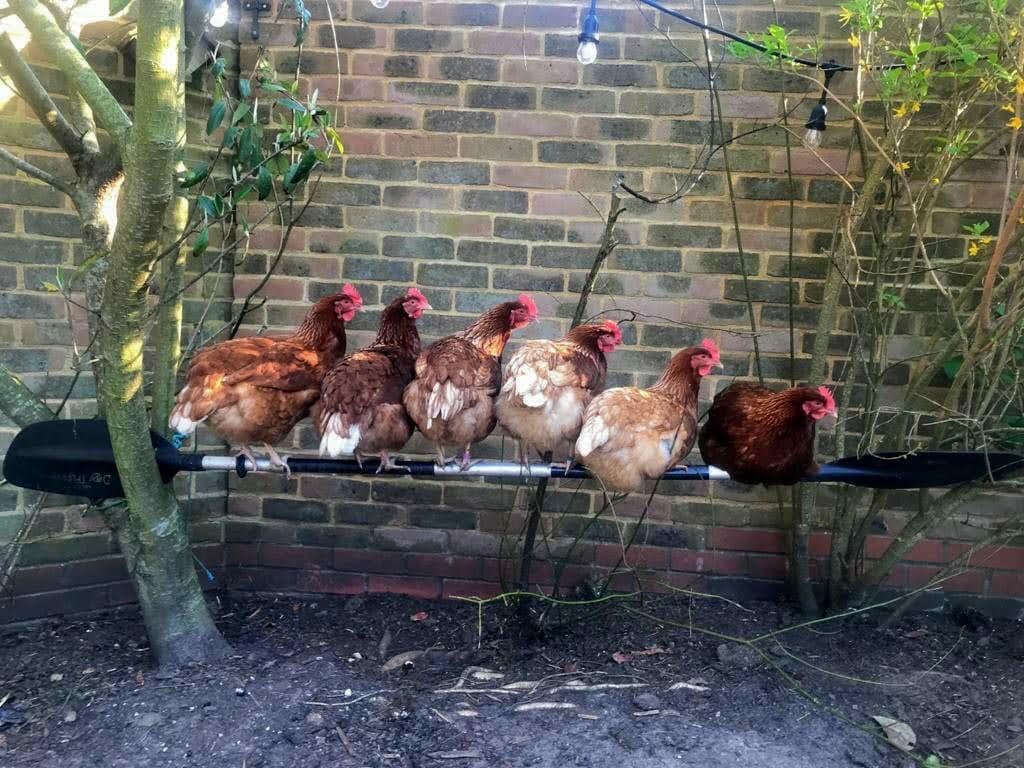
Henni Hen is a teaching assistant by trade. A cute and cuddly chicken who loves children. She follows in the footsteps of her bubbly humans, Hamish and Verity.
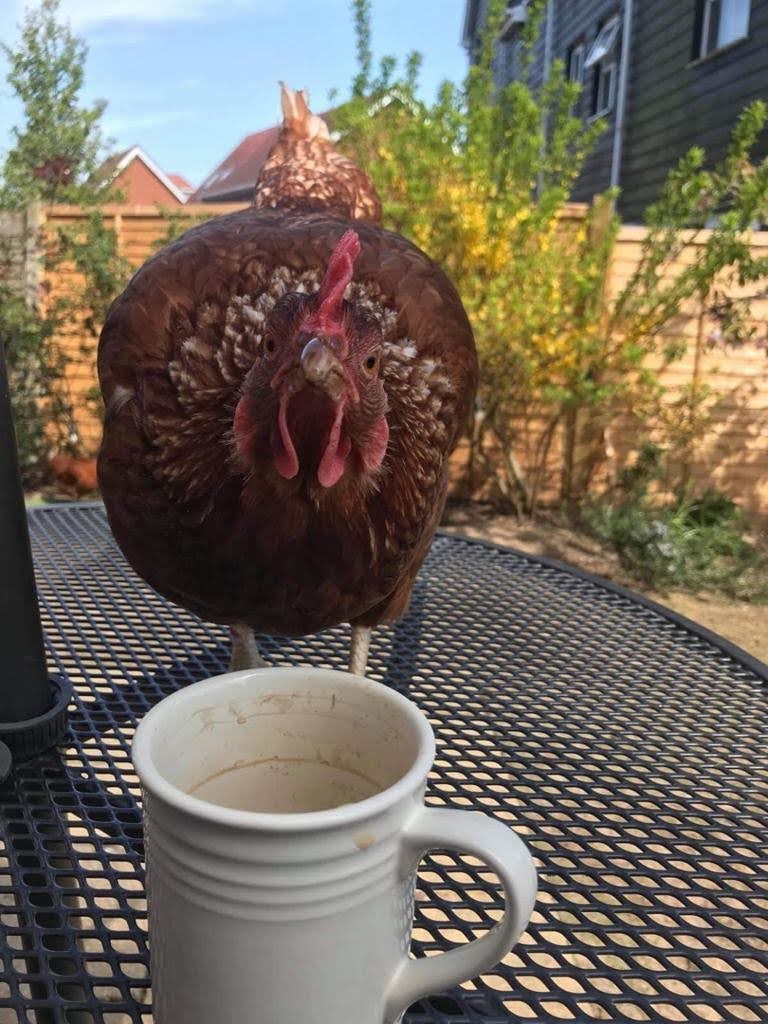
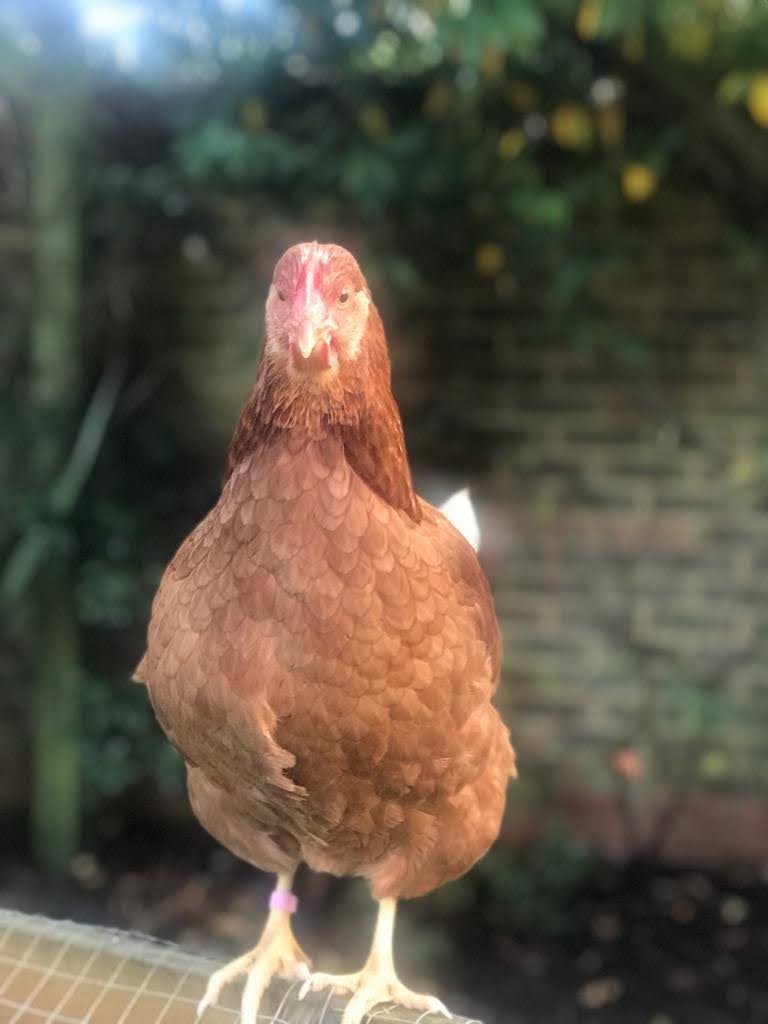
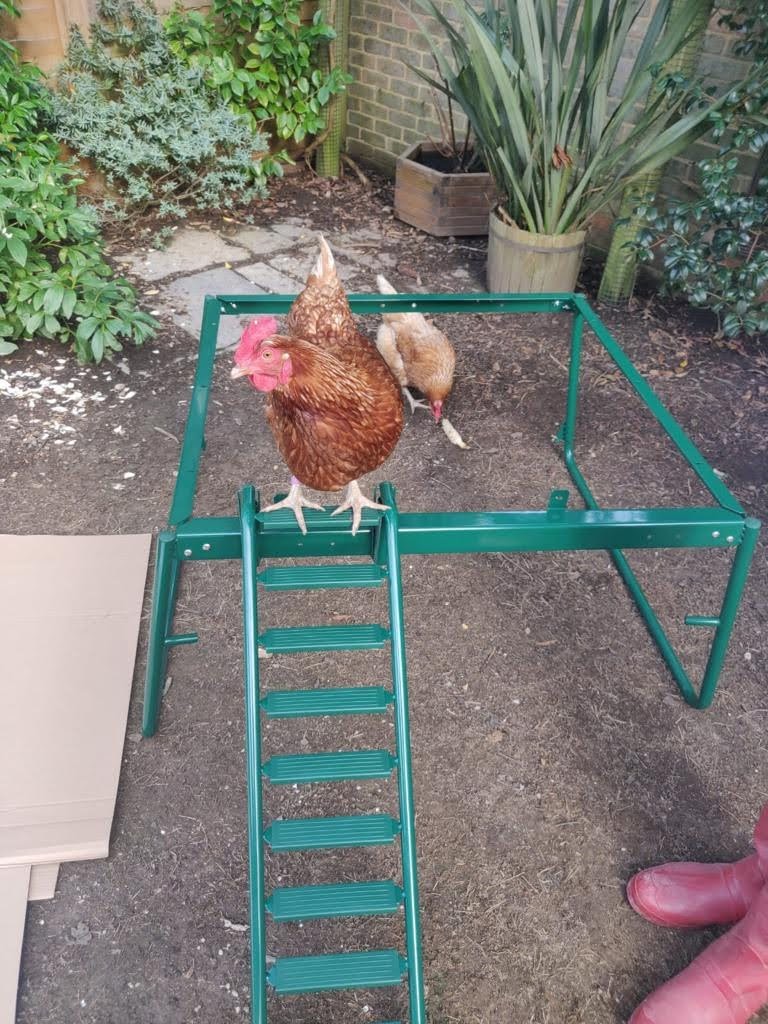
Verity hatches chicks in an incubator every year at the primary school in Kent, where she works as a reception teacher. It’s a highlight for the children in spring, with lots of learning opportunities and fluffy little chicks make Easter even more special.
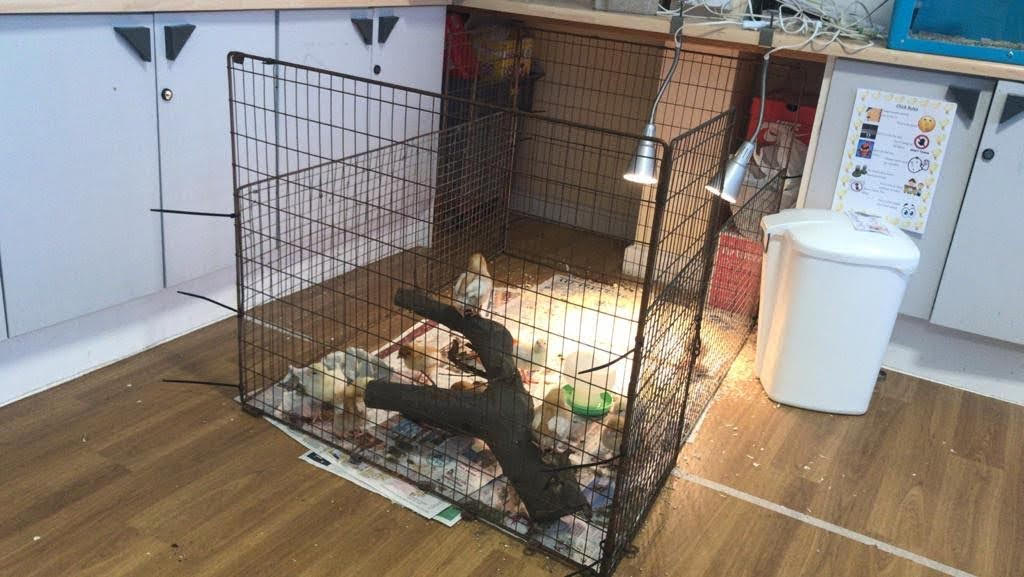
It was natural for Henni to become a teaching assistant at an early age. She was, after all, born in a school. Henni helped the children with topic work and became the subject of many good literacy and science lessons.
But Henni’s talent lies in her ability to help children read. Henni can’t read herself, but children who wouldn’t usually read to an adult began taking Henni to beanbag in a quiet corner where they could get cosy. Henni cuddles up and listens patiently to her young reader, giving the odd encouraging cluck.
When Henni and her sisters became too big for the classroom’s hutch, Verity and Hamish moved into a house with a garden. Instead of rehoming the chicks with local farmers (like they usually did), they decided to take Henni and her sisters home. They’d been talking about getting a dog, but both working full-time, the chickens seemed like a good option.
Most of the time, Henni is outside, like an ordinary chicken, scratching in the garden or getting up as high as she can. But Verity and Hamish potty trained her because she loves coming into the house for a cuddle, and of course, she needs to work.
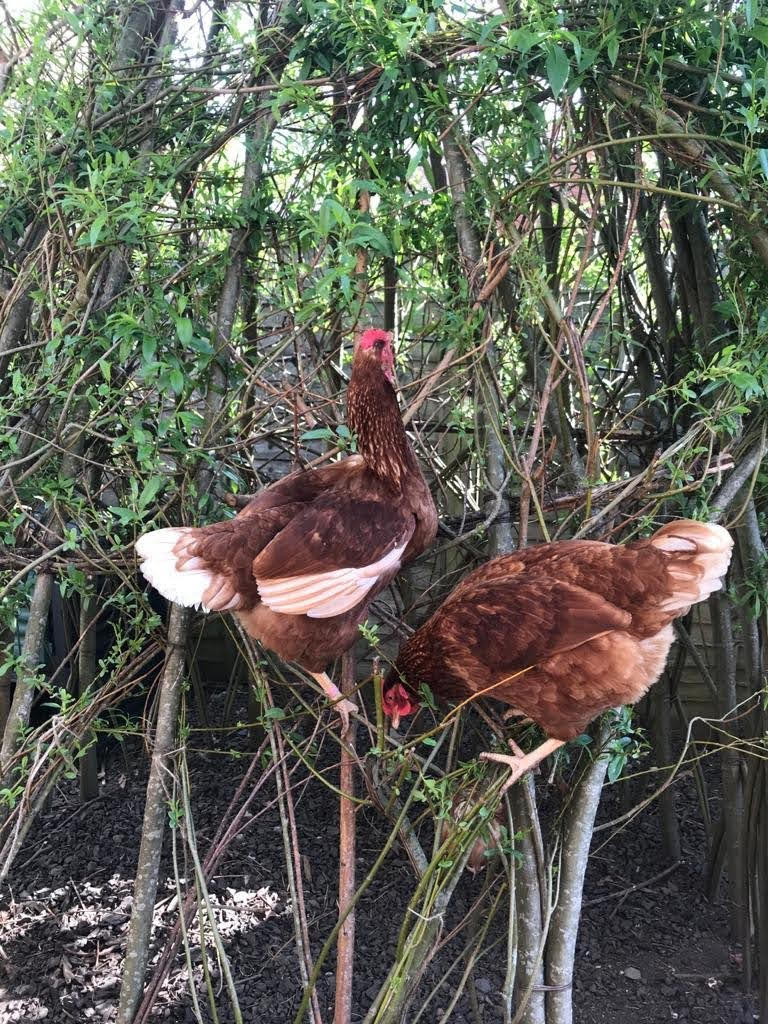
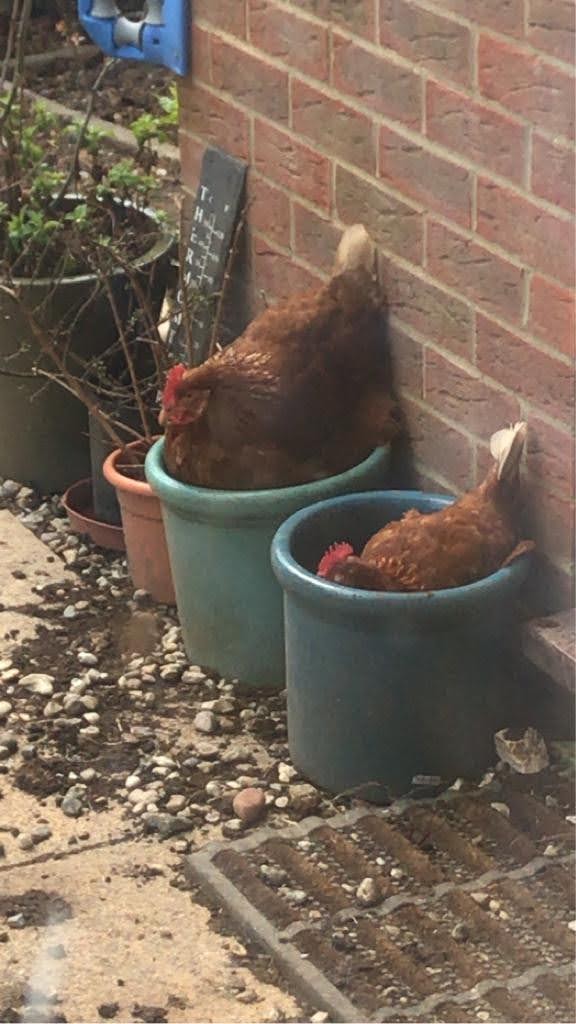
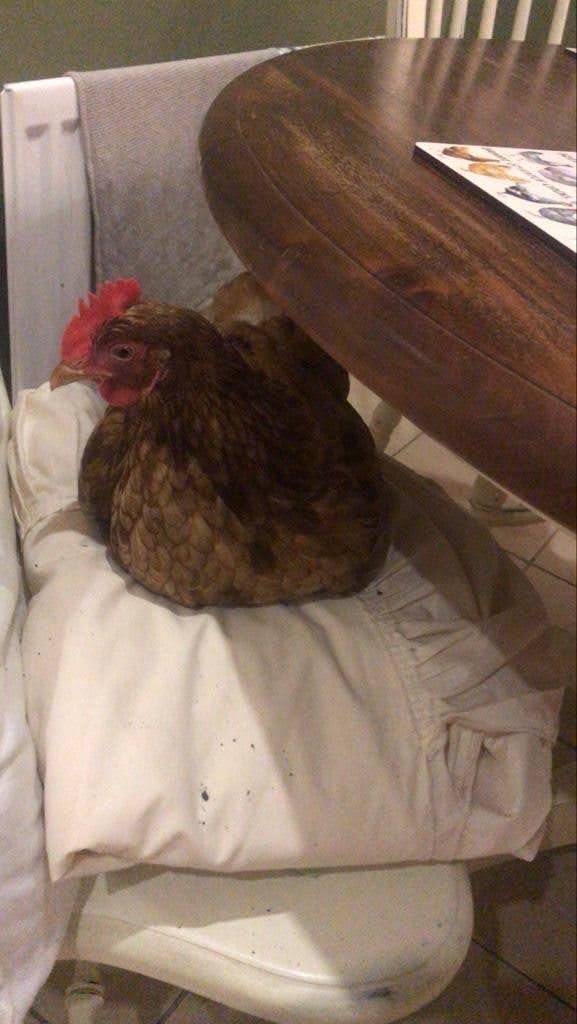
During the lockdown, the children missed holding Henni. So, Henni sprang into action and delivered both live and recorded lessons from the study that she shares with Verity. Verity read children stories, and Henni sat on her shoulder, making sure the children were listening. The deputy head called Verity regularly to make sure Henni’s doing ok.
Being a caring soul, Henni also gave to the community over lockdown. Together, Henni and her sisters lay six eggs a day, so Henni and Verity decided to do a doorstep delivery service for their neighbours. At 10 am, Henni would lay an egg and make a lot of noise about it, so all the neighbours knew when their eggs are ready. Then, Henni would hop onto Verity’s shoulder, and together they delivered eggs to all the houses on their close.
When she returned home, she’d often hop onto her favourite perch (the top of the garage), and the children from the neighbourhood would come over to Verity and Hamish’s to see “the one on the roof!”
Henni and her sisters Megg, Gertie, Margot, Ginger, Rona and Nora used to live in a wooden coop in the garden and come into the garage in winter when it was cold, but Verity and Hamish wanted the best for them. So last year, they got a new home, an Omlet Eglu Cube, and now they’re cosy outside all year round.
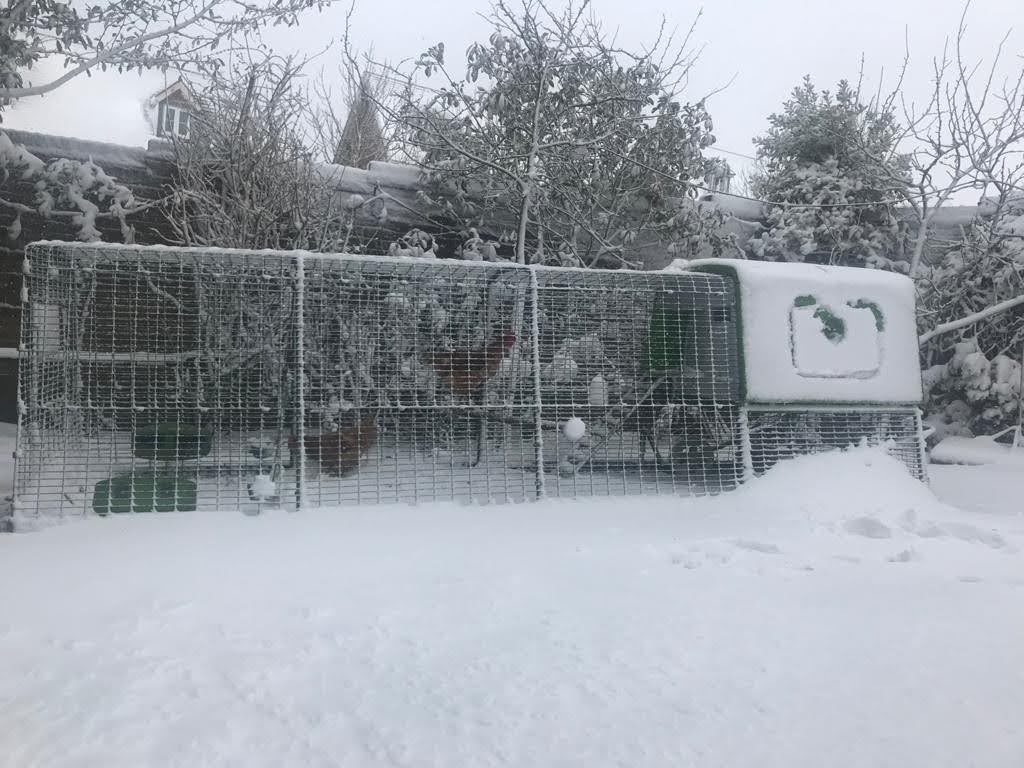
But Henni still likes to come inside for a cuddle and can often be found sitting on the sofa between Verity and Hamish for a family film night after a hard week at work.

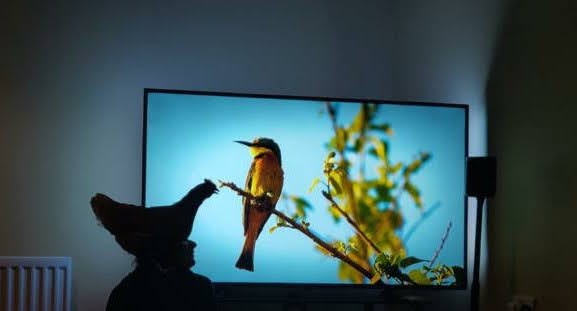
She’s just an ordinary brown chicken, and she’s low in the pecking order, but she’s got high hopes for the world. She’s very special to the children she teaches and the community she lives in, and of course, to her humans Verity and Hamish. She’s worthy of a gold star for an outstanding effort.


This entry was posted in Chickens
Everyone loves to stroke, cuddle and pamper their pet. Their fur is soft and warm, and stroking a dog or cat can help humans relax and destress. But despite these positives, your pet’s loose hair can invade your living space, settling on carpets, sofas, beds and furniture. It can be difficult to get rid of. So how can you avoid spending hours cleaning up after your pet?
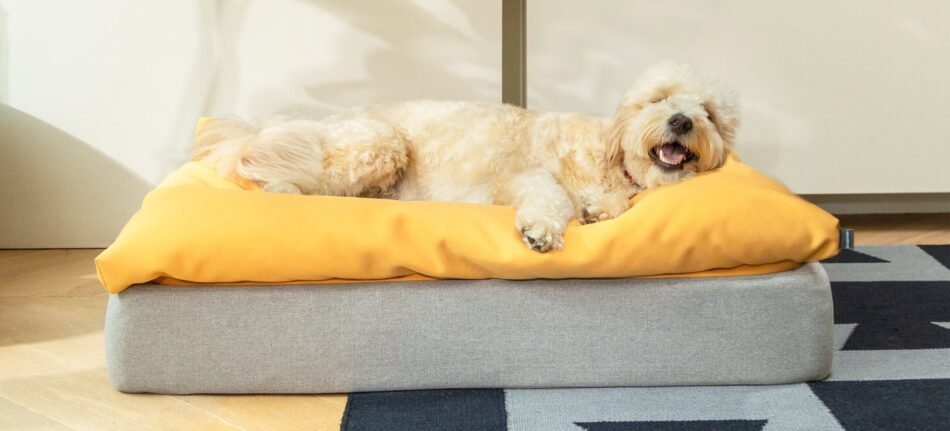
Removing fur to help pet allergies
Do you often have red, swollen eyes, a runny nose and experience persistent sneezing? If so, it could be because of your pet’s fur. Did you know, 40% of European cats are carriers of a bacterium: Bartonella henselae? Researchers thought that this bacteria could only be transmitted through your pet’s scratch, but numerous studies have shown that the bacteria can be transmitted through fur and fleas. This is why it is important to treat your pet and wash your hands after petting it.
Pets affect the quality of the indoor air we breathe. Hair and saliva carry allergens and can cause nose, throat and eye irritation, asthma and breathing difficulties.
So how do you deal with pet hair?
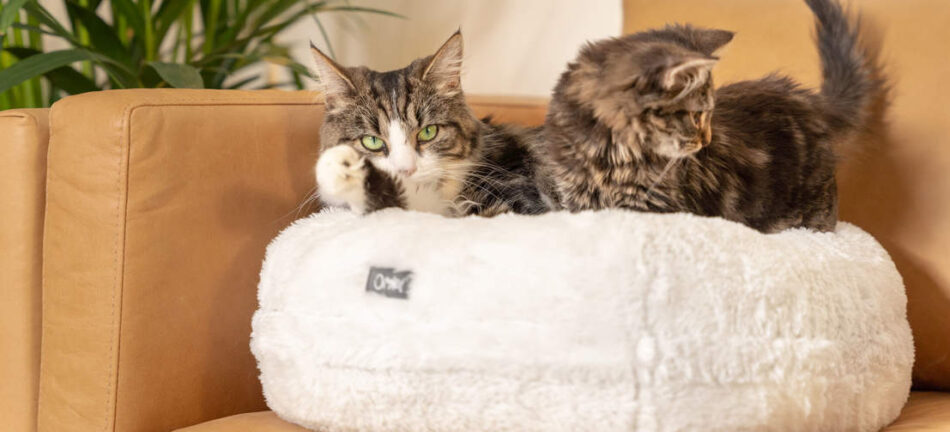
Useful techniques to get rid of hair
Removing pet hair from your home doesn’t have to be a time consuming task. Here’s a few tips and tricks to try…
Brush your pet’s hair regularly, preferably outside, but if that’s not possible, an easy clean area such as the bathroom may be just right. By brushing your pet, you allow it to shed any hair that may have otherwise fallen onto your sofa or other surface in your home. You can gather the hair in one place and you clean it up much more easily and quickly.
Protect furniture and areas where your pet likes to lounge. Your furry friend is bound to have a special place where he likes to spend time napping and grooming, and these areas can become loose fur hotspots! Try covering your pet’s favourite patch with a towel or blanket.
The ultimate appliance: the hoover. Cleaning your home is essential in normal times, and even more so when you have furry pets. This solution seems obvious and yet it is radically effective. Choose a hoover over a broom. A broom tends to make the hair fly around and instead of getting rid of it, you move it around to other surfaces. You can also vary the end caps to suit all surfaces.
Use dishwashing gloves! An original but effective tip. Use a pair of washing-up gloves to pick up your pet’s hair in a circular motion from the desired spot. The hair will stick to the glove and can be rinsed away.
Use moisture to quickly gather the hair into small balls. Take a damp sponge or flannel and wipe the desired area. Some of the hairs will cling to the sponge while others will clump together. This method should be combined with other techniques to effectively remove your pet’s hair.
The well-known method: the adhesive roller. Using an adhesive roller is particularly effective on your clothes, especially if you do not want to wet them with a sponge. The hair will stick to the tape and lift from the material. This technique is super effective on small surfaces. However, the roller soon becomes full of hairs and it is necessary to change the roller regularly if attempting larger surfaces in your home.
Use specific brushes: velvet brushes, electrostatic brushes, etc. There are all kinds of useful brushes on the market. With a simple movement of the hand, they attract the hair to the brush and lift off your soft furnishings.
Static electricity with tights! Don’t just throw away your frayed tights, they can be reused to pick up your pet’s hair. The friction creates static electricity and attracts the hair to the nylon material.
Ventilation: renewing the air to reduce the concentration of hair in one place. Whether you have pets or not, airing your home is essential to prevent the accumulation of dust and bacteria. You will eliminate bad odours and allow for fresh air to circulate the home.
If you really need to keep an area hair-free, the most effective method will be to restrict access to your pet. It may be drastic, but you won’t have to worry about hair in your bedroom causing irritation while you try to sleep, for example.
Your pet’s fur will always be present, and impossible to eliminate entirely, however, these little tricks will help you to considerably reduce the accumulation of hair in your home and allow you and your pet to live in a healthy, comfortable and hygienic environment.
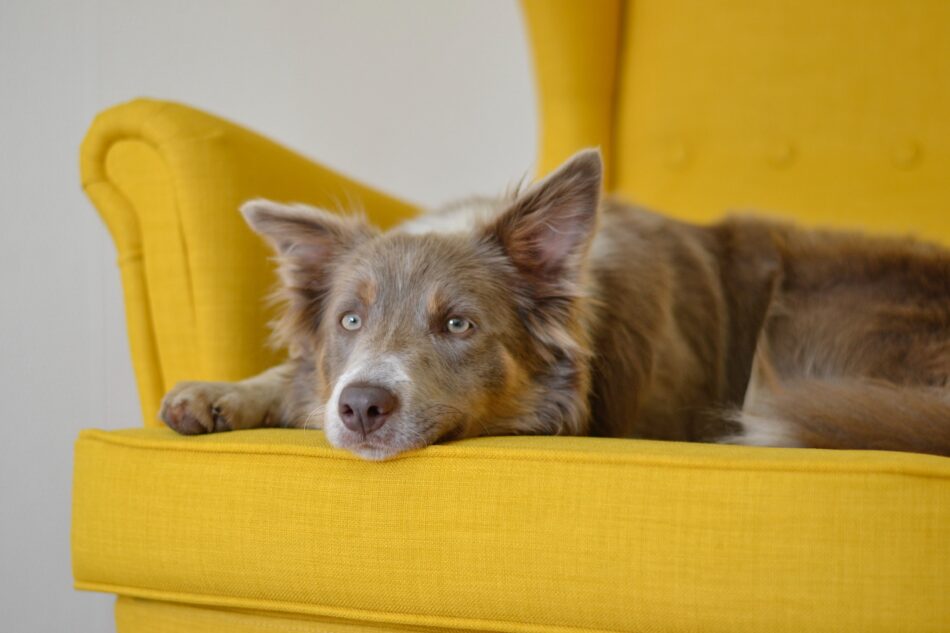
This entry was posted in Pets
Pets are like children. In search of adventure and new experiences, they will tend not to see the danger. Carefree, they want to touch everything and are always very curious. Greedy by nature, they do not distinguish between what is good or bad for their health. However, even if you are conscientious and careful, your home can often be a source of danger. We have put together a list of 10 products to keep away from your lovely animals.

Image by Gundula Vogel from Pixabay
If you have read our article on “Pet Days to Celebrate: The Top List in 2021” you should know that March is a month dedicated to the prevention of pet poisoning.
When owning an animal, there are precautions to take. Be aware that many visits to the vet are caused by poisoning due to ingestion of toxic products. It is therefore important to store certain items in secure cupboards and only use them when your pet isn’t around. Swallowing or breathing toxic substances can be dangerous for your pet and can lead to death. Ensuring that the environment in which your pets grow up is safe should be a universal reflex.
10 items dangerous to pets
We will focus on10 common products, but this list is not exhaustive and you should use your instinct and common sense to detect any form of danger for your companion.
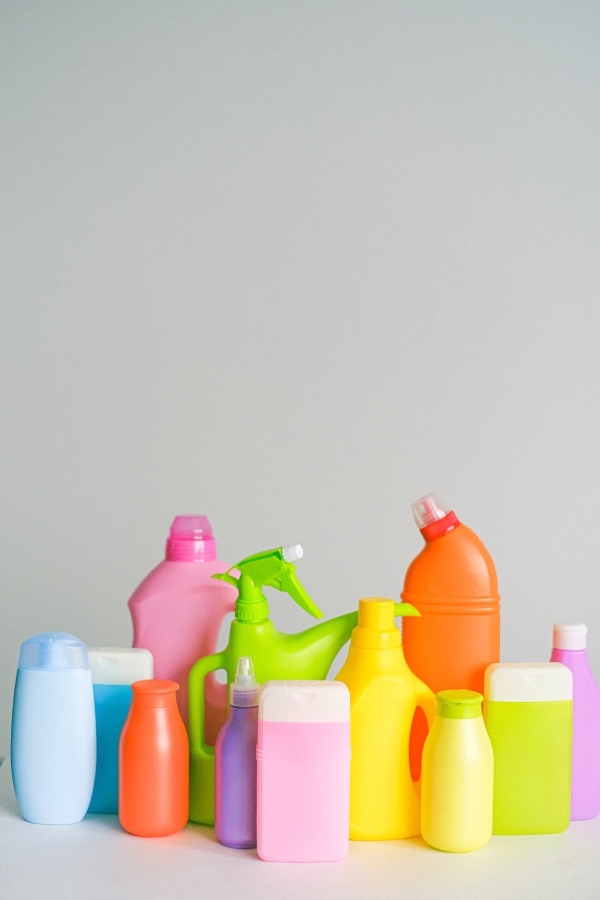
1. Toxic household products for your pet
Most of the time, these are corrosive products that cause chemical reactions by coming into contact with your pet’s fur or skin or by causing internal burns after ingestion. Detergents should be raised or stored. This includes your dishwashing liquid, hand soap, and laundry detergent. Keep your pet away from any of these products or the foam created by any of these products. The risks: diarrhea, vomiting, abdominal pain, breathing difficulties and even the risk of pneumonia.
Cleaners should also be kept out of the reach of your pets. Often composed of harmful chemicals, they can cause serious risks to your pet. Deodorants, drain openers, bleach and toilet cleaners should also be kept away.
With COVID-19, we tend to leave our disinfectant gels lying around. Be careful that your pets don’t go near them. They could easily want to play with it.
Be careful with garden products for your plants, patio and paddling poo tool.
In order not to end up at the vet, we advise you to put your products in cupboards, to raise them up high or to opt for non-toxic products. Indeed, some non-toxic products exist in specialised stores and if you have time and desire you can even create them yourself.
Image by Anna Shvets from Pexels
2. Food for Humans

Not all food is good for animals. Chocolate is one example which should not be given to your pet. Don’t leave your cookies lying around on the table (your cat could easily pass by) and watch out for crumbs left on the floor.
Theobromine and caffeine are intolerable substances in our animal friends. When ingested, your pet may start shaking, may have palpitations, abnormal blood pressure, and stomach upset. In severe cases, consuming theses foods can also result in death, therefore, this is not something to be taken lightly and remember to clean up well after eating.
Avocado, grapes and raisins should also be avoided in your dog’s diet, as should alcohol, Xylitol, garlic and macadamia nuts.
3. Pest traps and insecticides
Do you want to get rid of insects or pests? Pay attention to the traps you install. Your pets may want to play with them or be attracted by the smell. The modern bait that we can find on the market uses few chemical and toxic products. However, be sure to read the instructions and restrictions on the packaging. Products to be avoided include substances such as methomyl and metaldehyde.
Mouse traps are also to be avoided because the food in them may attract your pet. Rat poisoning consists of alpha-chloralose and anticoagulants, which can cause nerve damage and blood disorders.
Image by Charles Deluvio from Unsplash
4. Medicines for your pet but also yours
Medicines for humans should never be given to an animal. Consider them all as toxic! Acetaminophen and ibuprofen are very good examples. They should not be given to your pet if it is not feeling well.
It is imperative to always consult your vet.
Don’t leave your pet’s medication lying around. Some medications may be flavoured to make them easier to swallow. However, they may be perceived by your pet as a treat who could consume an excessive dose by mistake.
Also remember not to mix cat medications with dog medications if you have more than one pet. Professional advice is essential to avoid mistakes and missteps that could result in a trip to the animal hospital!
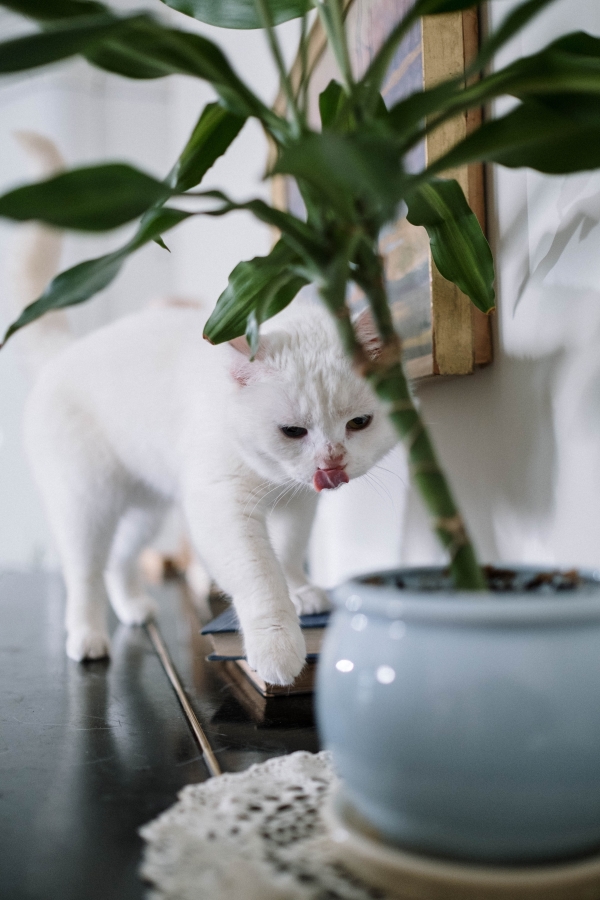
5. Plants
Stomach problems often cause your pets to chew plants. It is necessary that you check the plants and flowers in your garden and your home to determine if they may be toxic to your pet.
Dogs, for example, cannot tolerate chrysanthemums, yew, amaryllis, cyclamen, rhododendrons, oleanders and narcissus and hyacinth bulbs.
For cats here are some plants to avoid: ficus, Philodendron or Monstera Deliciosa, lily of the valley, cyclamen, aloe, Yucca, Sansevieria…
6. Fertilisers
Fertilisers are potentially dangerous for your animals. They come in many kinds and forms. Depending on the nature of the fertiliser, the toxicity can vary. Choose them well and try to go for as natural as possible. Avoid products composed of phosphorus, potassium and nitrogen, as well as additives such as herbicides and insecticides.
The potentially toxic dose in a dog is estimated to be 5g/kg if ingested by your canine animal.
Organic fertilisers are not necessarily good for your pet’s health. Always check the packaging or ask for information from specialised professionals.
Image by cottonbro from Pexels
7. Heavy metals
Care should be taken with lead and Zinc, which can have negative effects on your pet. Pick up your pennies when they fall on the floor and don’t leave your coins lying around.
Ingesting heavy metals can cause stomach aches and even lead to anemia.
Also be careful when restoring old buildings and houses, lead could easily be ingested by your pet.
8. Essential oils
Although they have many virtues, essential oils are not harmless. They are powerful active substances that must be kept away from your animals. Essential oils can cause digestive and nervous damage and can cause burns if touched.
9. Nicotine, tobacco and other drugs
Nicotine is as harmful to humans as it is to animals. Do not smoke in front of your pet and avoid leaving a pack of cigarettes on your coffee table. If ingestion or inhalation of high doses occurs, your pet may have respiratory or even cardiac problems.
10. Some cosmetic products
Cosmetic products for humans contain many substances that are often harmful to your pet. Keep your deodorant, varnish, solvents and perfumes away.
Do not brush your pet’s teeth with conventional toothpaste. While fluoride is good for our teeth, it is absolutely not good for our beloved pets. Fluoride is toxic and could be accidentally swallowed by your pet.
My pet has been in contact with an item on this list, what should I do?
If you notice symptoms (red skin, loss of appetite, fever, severe salivation, vomiting, difficulty breathing, joint and abdominal pain, sudden fatigue, etc.), contact a vet immediately. They will tell you what to do. Any information helping to identify the source of the poisoning should be given to the professional contacted.
Do not try to make your pet vomit, give it water or medication, which would only make the situation worse.
Loving your pet also means protecting it from danger. The house is their main playground, protect your pet from these common dangers by taking care to secure them away out of reach.
This entry was posted in Uncategorised
There are days that matter. Days we don’t want to forget and days we want to celebrate. There are dates that we want to mark: Christmas, Easter, Thanksgiving… And dates that we would like to know. While certain symbolic days are easy to remember, sometimes we need to refresh our memories. Our pets also have the right to their glory days! Here are the key dates to know in 2021!

Photo by Glenn Han on Unsplash
The list below is not exhaustive and takes into account the days established in some countries and not in others. However, we love any excuse to celebrate our pets so thought you’d love to here of these special days too!
Summary
January
February
March
April
May
June
July
August
September
October
November
December
January
The month of January is already almost over but nothing prevents us from taking a retrospective of past events.
Throughout January, two actions were put forward:
- Adopt a rescued bird. Birds were therefore honored in this month of January. Many cats and dogs are asking to be rescued every day, but it was important to put the birds in the spotlight! Thousands of them are looking for a home and a family to care for them. Birds are awesome, they are fun, social, and smart creatures. There are many owners who underestimate the workload around these little animals. Birds require a lot of attention and love. This is why the abandonments are numerous and the shelters overwhelmed.
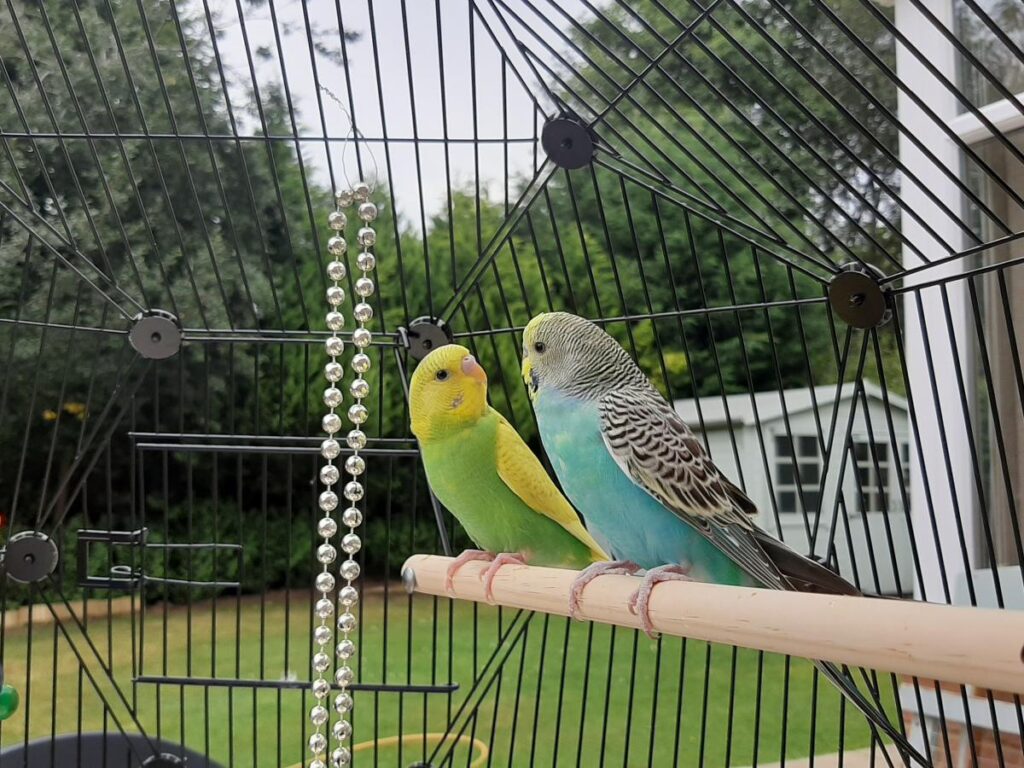
- National Train Your Dog Month (US): A movement started by the Association of Pet Dog Trainers many years ago. This month is your chance to teach your dog new tricks. During the month of January, social networks become a real source of information for dog owners with tips and advice. Feel free to browse Instagram, Facebook, Youtube and Pinterest. This is the time when trainers, canine experts, and dog owners come together to celebrate their love for their pets. Remember three essential things for your dog to learn in good conditions: loyalty, love, fidelity.

Specific Days in January for pets:
- Jan. 24: Change a Pet’s Life Day: a day especially created to encourage people to adopt pets from shelters. And if you are not ready to adopt, you can sponsor a pet. This system is done through shelters, do not hesitate to inquire directly with them! You can also think of volunteering. Associations always need help.
- Jan. 25: National Fun At Work Day
February
February is only 28 days but they are busy days. The month of February is particularly placed under the sign of health. Don’t forget to take your pet regularly to the vet. The all-important task is to spay our pets.
Throughout this February, two actions are put forward:
- Adopt a Rescued Rabbit Month: Rabbits make great pets too. Often forgotten like birds, the month of February allows these small animals to be honored. For people who have allergies to dogs and cats, adopting a rabbit may be an ideal solution! Allergies are actually less frequent. Rabbits bring joy and happiness, they are just waiting to join a loving family.

- National Cat Health Month (US): This month we are focusing on the well-being of our cats! Parents of cats, this is the time to take into consideration not only the physical well-being of your pet, but also the occasion to take into account its emotional well-being. It’s time to celebrate our furry friends. This month we take our cat to the vet, we flood it with love and why not buy our lovely cat a new toy… It’s a secret but…Many surprises are arriving this spring at Omlet for cat owners! Stay connected…

Specific Days in February for pets:
- Feb. 3: National Golden Retriever Day
- Feb. 3: Annual Doggy Date Night: dogs are an integral part of a family. It is essential to give them quality time. Take advantage of an evening with your dogs to show them all your love: pet them, share a movie with them, give them a gift and above all tell your dogs that you love them. This day reminds us how much our dogs bring us daily joy.
- Feb. 14: Valentine’s Day: Valentine’s day is not just for humans!
- Feb. 14: Pet Theft Awareness Day: This day reminds us how much a pet brings happiness to a family but it also reminds us of the responsibilities that go with it. This day emphasizes the importance of pet identification and encourages owners to take steps to ensure the safety of the animal.
- Feb. 20: Love Your Pet Day ???
- Feb. 22: National Walk Your Dog Day
- Feb. 23: World Spay Day: This day is an opportunity for shelters to highlight their spay program. World Spay Day shining a spotlight on the power of affordable, accessible spay/neuter to save the lives of pets and street dogs who might otherwise be put down in shelters or killed on the street.
- Feb. 27: Polar Bear Day: We leave the world of pets for a moment to highlight the importance of polar bear conservation who are an endangered species.
March
Throughout March, two actions are put forward:
- Adopt a Rescued Guinea Pig Month: Just like birds and rabbits, there are many guinea pigs in shelters! They are charming companions who will know how to bring joy at home. Guinea pigs are wonderful animals for your children. In addition to being excellent friends, they can also teach them empathy and responsibility.
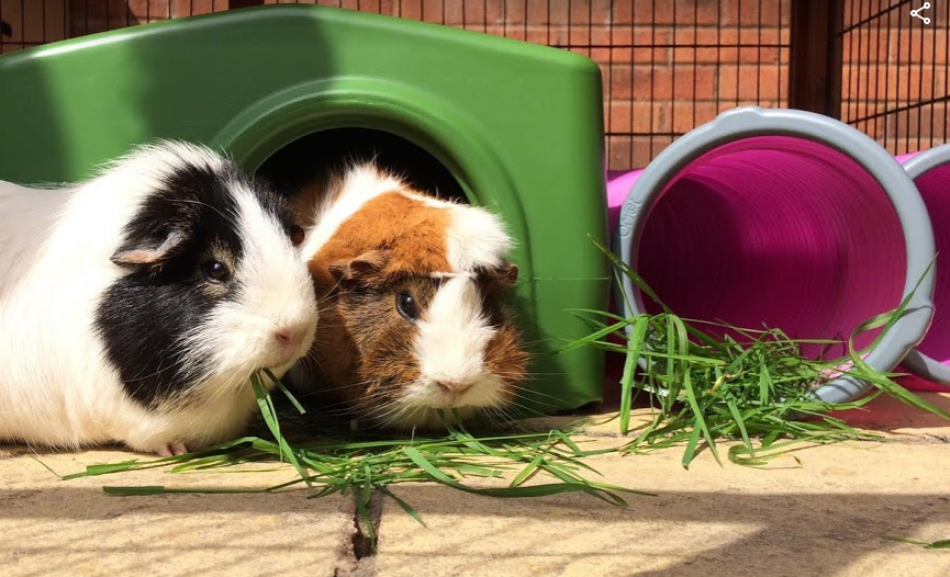
- Poison Prevention Awareness Month: Think you don’t have poison in your house? This day allows us to become aware of the products which surround us and which could be dangerous for our animals. Remember to store your products in your cupboards and not leave them lying around. Your animals are like children and they could easily swallow or inhale a substance dangerous to their health which could even lead to death. This period was established in the United States but it is important for any person in possession of a pet in the whole world to take note of it.
Specific Days in March for pets:
- March 3: If Pets Had Thumbs Day: Yes this day exists and it’s a funny one! It comes straight from the United States and allows us to imagine the life of our dog with thumbs.
- March 20: World Sparrow Day
- March 23: National Puppy Day (US): this day celebrates all the love that puppies bring us. You might see a lot of social media posts emerging on this day! This day makes us aware that puppies are a big responsibility. This day also exists to educate people about the horrors of puppy mills across the world.
- March 23: Cuddly Kitten Day
- March 28: Respect Your Cat Day: give them the attention they deserve!
- March 30: Take a Walk in the Park Day
April
Some important aspects of pet care are highlighted in April.
Throughout April, two actions are put forward:
- National Pet Month (UK): This month is a time to educate pet owners about the responsibility of having a pet at home. Through numerous campaigns and an educational approach, associations hope to raise awareness.
- Prevention of Cruelty to Animals Month: This month is also the time to speak out and take action! Do not hesitate to condemn any behavior that could endanger an animal. The month of March is an opportunity to help associations by giving or volunteering. Your actions may be able to save lives.
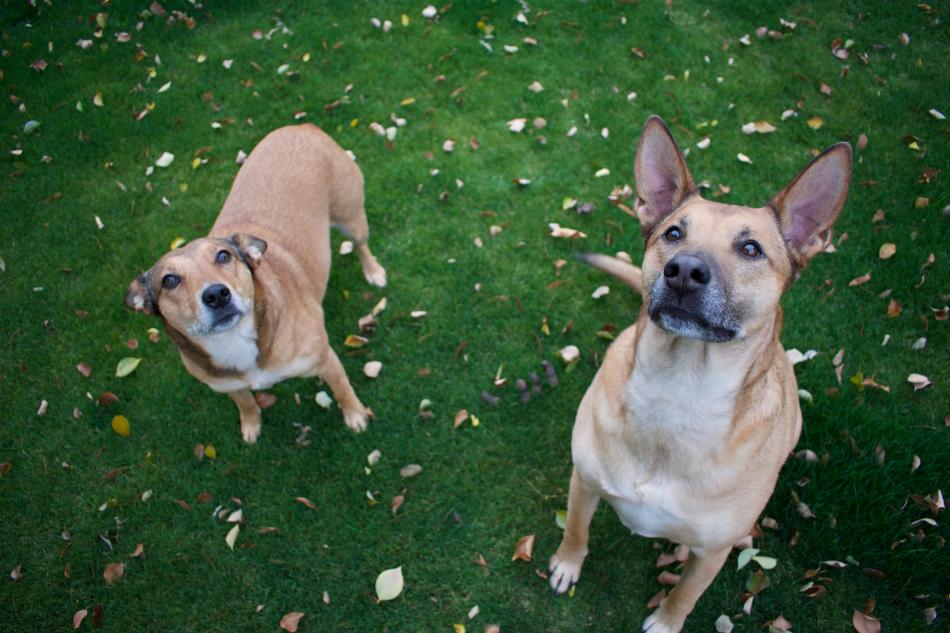
Photo by Caleb Carl on Unsplash
Specific Days in April for pets:
- April 4: Easter: Easter emblems: a rabbit, a chicken and a bell
- April 8: National Dog Fighting Awareness Day
- April 11: National Pet Day
- April 11: Celebrate Shelter Pets Day
- April 11: Dog Therapy Appreciation Day
- April 12: World Hamster Day: hamsters also have the right to their glory day!
- April 23: National Lost Dog Awareness Day
- April 24: World Veterinary Day: This annual celebration aims to highlight a profession: veterinarians. This day underlines the vital role of this profession in also ensuring animal welfare, safe world trade in animals and animal products as well as protecting public health.
- April 25: National Pet Parents Day
- April 26: National Kids and Pets Day (US): This day is mainly celebrated in the United States however it can easily be highlighted in other countries by offering activities bringing together your children and pets! Why not do a family outing on April 26? Play hide and seek all together in the garden? So much activity exists!
- April 28: International Guide Dog Day: It is important to pay tribute to these dogs who allow their owner to socialize with the outside world. These dogs are very supportive and do an amazing job. They bring love, comfort and help.
- April 30: Adopt a Shelter Pet Day
- April 30: National Therapy Animal Day
- April 30: Hairball Awareness Day
May
In May, we celebrate the different breeds of dogs. We also do not forget the importance of microchipping your pets!
Throughout May, two actions are put forward:
- Chip Your Pet Month: This month the focus is on the microchip. It’s a perfect time to spread knowledge about microchips. The American Humane Association evaluates that one in three animals will be lost or stolen in their lifetime. The microchip is like your pet’s identity card. If lost, your pet has a better chance of finding you if they are microchipped.
- Pet Cancer Awareness Month: Did you know that cancer is a leading cause of disease-related death in cats and dogs? This month emphasizes the importance of a good medical follow-up of your animal.
Specific Days in May for pets:
- May 1: National Purebred Dog Day
- May 3: National Specially-abled Pets Day (US): Disabled animals are highlighted on this day. These animals have an immense need for love. Know that they will know how to return it to you.
- May 8: Vet Nurse Day
- May 8: National Animal Disaster Preparedness Day
- May 8: National Dog Mom’s Day
- May 14: International Chihuahua Appreciation Day: And yes, chihuahuas have the right to have their own day! In addition, this day is international! They are the kings.
- May 20: National Rescue Dog Day
June
In June, shelters see an abundance of kittens arriving.
Throughout June, an action is put forward:
Adopt-A-Cat Month / Adopt a Shelter Cat Month:
As stated in this article, adoption is a laudable alternative. By welcoming an abandoned cat, you are giving it a second chance to live the life it deserves. Cats need to be loved, and while shelters do an amazing job, nothing beats a family to take care of them.
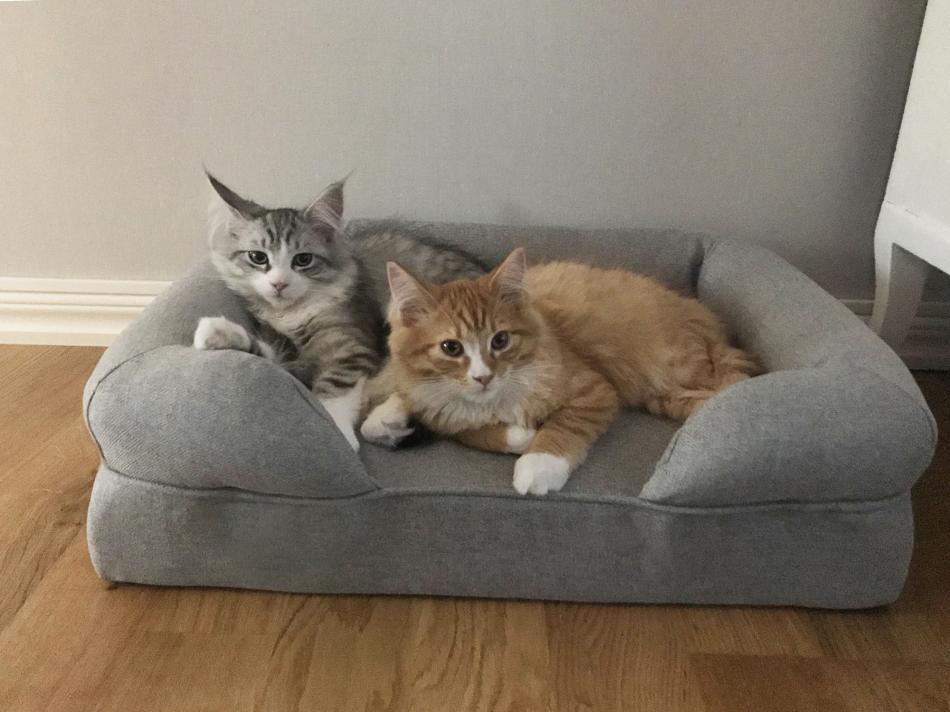
Specific Days in June for pets:
- June 4: Hug Your Cat Day: Hugs day is normally everyday for your cat. But we like to remind you that there is a specific day for that so this day make sure to give twice as much hug for your lovely cat!
- June 8: Best Friends Day: If we celebrate best friends, it’s not just human beings. Who is more loyal than your dog? Who is more fun than your bunny or even your little chickens?
- June 8: World Pet Memorial Day: It is a day dedicated to all our pets gone to paradise.
- June 21: Take Your Cat to Work Day: Try asking your boss first though in case they’re allergic…
- June 24: Cat World Domination Day: Oops it’s a secret…
- June 25: Take Your Dog to Work Day
July
In July we take care of our pets. It’s summer, it’s hot, we try to be vigilant. We think of hydration!
Throughout July, an action is put forward:
National Pet Hydration Awareness Month (US): It is a month dedicated in United States but it should also be for every country in the world that happens to be in the summer at this time of the year. Your pets need to drink. Don’t forget them!
Specific Days in July for pets:
- July 5: Pet Remembrance Day
- July 16: Guinea Pig Appreciation Day
- July 21: National Craft for Your Local Shelters Day: This is the perfect day to make something for the pets in shelters. It is also a perfect activity to offer to your children!
- July 21: No Pet Store Puppies Day
- July 30: International Friendship Day: Here again we celebrate our friendship with our lovely animals!
August
In August, we take advantage of our pets. Many activities are to be discovered with your furry friend!
Specific Days in August for pets:
- Aug. 1: DOGust Universal Birthday for Shelter Dogs
- Aug. 4: Assistance Dog Day
- Aug. 6: Fresh Breath Day
- Aug. 8: International Cat Day
- Aug. 10: Spoil Your Dog Day: On this special day, spoil your dog with little treats, participate in activities and above all spend time giving him lots of love.
- Aug. 21: International Homeless Animals Day: This particular day symbolizes the fight for better legal and physical protections for our pets.
September
Specific Days in September for pets:
- Sept. 1: Ginger Cat Appreciation Day
- Sept. 8: National Dog Walker Appreciation Day
- Sept. 13: Pet Birth Defect Awareness Day: This day was established by David Rogers in order to bring awareness to the “interactive role humans play in our pets’ physical birth defects as well as their mental health”
- Sept. 17: National Pet Bird Day
- Sept. 25: International Rabbit Day: This day is dedicated to our little rabbits. Take out its favorite toys, carrots and a nice obstacle course so he can let off steam!
- Sept. 25: World’s Largest Pet Walk (US): This day is organized by an association Pet Partners and allows fundraising. It is about promoting the physical activity shared with his pets.
October
In October, we pay attention to what our pets eat! Obesity is a problem that our furry pets can face.

Image by LorysCats from Pixabay
Throughout October, an action is put forward:
Adopt-A-Dog Month/Adopt a Shelter Dog Month: Like cats, dogs have one month dedicated for adoption. So we can never repeat it enough but if you want to adopt, think above all about shelters!
Specific Days in October for pets:
- Oct. 4: World Animal/Pet Day
- Oct. 13: Pet Obesity Awareness Day: Obesity in our animals is not to be taken lightly. A obist problem in your pet can lead to other health problems and affect the quality of life of your companion. It also interferes in all the activities that he is called upon to do: walking, running after a ball. These activities are nevertheless so dear to his heart.
- Oct. 27: National Black Cat Day (UK): We did a recent article about black cats, read it here!
- Oct. 28: Plush Animal Lovers’ Day: Ideal day to buy your pet a new toy
- Oct. 30: National Pit Bull Awareness Day
- Oct. 31: Halloween: We are careful not to leave chocolate lying around! It’s not good for our furry pets.
November
Throughout November, an action is put forward:
Adopt a Senior Pet Month: The whole month of November highlights the adoption of a senior pet. A month dedicated to older pets to find a lovely home. Dogs and cats of advanced age have higher euthanasia rates. There are many advantages to adopting an older pet: they are calmer, it is easier to teach them new tricks, they require less attention than a puppy.
Specific Days in November for pets:
- Nov. 1: National Cook for Your Pets Day (US): It’s an excellent idea to test new recipes and share them with your furry friends.
- Nov. 17: Take a Hike Day
- Nov. 25: Thanksgiving (U.S.)
- Nov. 28: Hanukkah Begins
December
December, it’s gifts month!
Specific Days in December for pets:
- Dec. 5: International Volunteer Day: the opportunity to volunteer with an animal association
- Dec. 9: International Day of Veterinary Medicine
- Dec. 24: Christmas Eve
- Dec. 25: Christmas: Gifts are also for our animals!
- Dec. 31: New Year’s Eve
There are many, many dates that celebrate animals around the world. If you are not celebrating a particular date, that’s okay, the most important thing is to give lots of love every day to these pets who bring you joy and happiness all year round!
This entry was posted in Uncategorised

Looking after a pet is a big responsibility. Not because it’s difficult or requires lots of time – neither of those are necessarily true – but because a pet is a living thing. It will rely on you as its friend and carer, its source of food, warmth and shelter.
If you can provide those things, keeping pets is without doubt one of life’s great pleasures. There’s often a big stumbling block though. If Mum, Dad or another well-meaning adult at home says you can’t have a pet, what’s the best way forward?
You could always accept it, of course – and maybe there are good reasons why, in your particular household, keeping a pet just isn’t going to work. For example, if you’re under 10 it’s not recommended that you should take full responsibility of a pet – you will need an older person to help out.
However, if the adult in question has simply not stopped to think about it, you’re in with a chance. For many of the commonest anti-pet arguments there are simple, practical facts that may help you change your parent’s mind.
Arm yourself with these, and you could soon be the proud owner of a new furry or feathered friend!
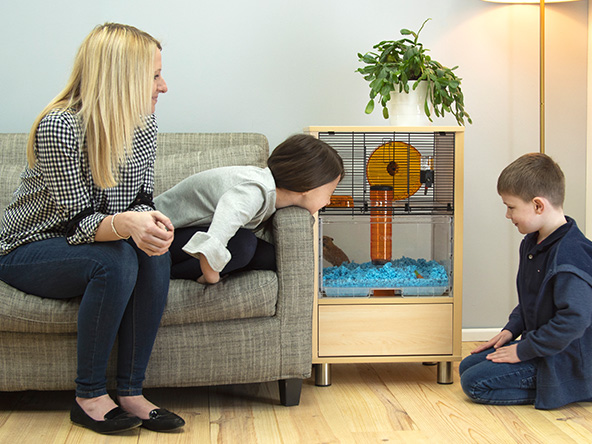
1 – Mum says: “Pets take too much looking after.”
You say: “It doesn’t have to be something that needs lots of training and walking, like a dog. A cat is pretty independent and easily house-trained. A small mammal like a gerbil or hamster only needs cleaning out once a week, and feeding them every day is simple. The same goes for budgies and finches.”
2 – Dad says: “We can’t afford to keep a pet.”
You say: “Small mammals are very cheap to buy. Or we could get a pet from a pet rescue centre. They’re always looking for new owners, and we’d be helping out an animal in need, and supporting a very important local service. As for pet food, even a big dog will only cost a few pounds a week, and a small pet will spend a month nibbling through a $10 bag of food.”
3 – Mum says: “Yes, but what about those huge vet’s bills?”
You say: “Gerbils and hamsters don’t usually have many health problems in their short lives, and don’t need vaccinations and microchips like dogs and cats. And there’s also pet insurance – for a fairly low monthly premium, a pet can be covered for all kinds of potential problems. That way we can avoid unexpected vet’s bills.”
4 – Dad says: “Pets are too noisy.”
You say: “Okay, dogs are noisy, but they can be trained not to woof too much. Chickens are quite noisy, but we could run it past the neighbours, and I’m sure the promise of a few eggs would win them round! Pet birds make a lot of noise, but how about the gentle squeak of a guinea pig, or the soft purring of a cuddly cat? And rabbits, gerbils and hamsters are pretty much silent.”
5 – Mum says: “They make too much mess.”
You say: “Cats are very neat and tidy. Small mammals make their mess inside their enclosures, and I can clean that up every week.”
6 – Dad says: “Pets are smelly.”
You say: “Not if their cages are cleaned properly every week. And dogs can be shampooed.”
7 – Mum says: “All that cleaning out… I’m not going to do it!”
You say: “Modern hutches and chicken coops are really easy to clean, and I could definitely manage it myself. Take a look at the Eglu for chickens, and the Go Rabbit Hutch, and you’ll see what I mean.”
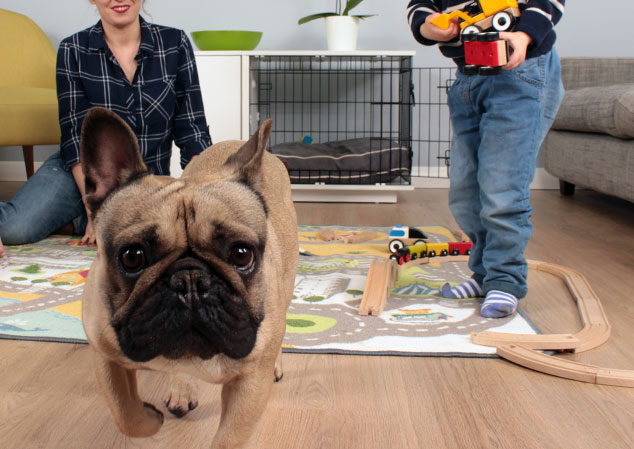
8 – Dad says: “You’re forgetting – someone at home is allergic to fur and feathers.”
You say: “There are hypoallergenic breeds of cat and dog, so let’s get one of those.”
9 – Mum says: “During term time there’s no one at home to keep the pet company.”
You say: “Some dogs are absolutely fine on their own for a few hours. Most cats are too. You just need to get one of the chilled-out breeds. And all small mammals and cage birds do just fine without a human around 24/7. Same goes for chickens – and you can even get automatic chicken coop doors for them these days.”
10 – Dad says: “But what’s the point?”
You say: “Pets are beautiful. They’re our best friends. Research shows that handling pets relieves stress. And chickens produce lots and lots of delicious eggs!”
This entry was posted in Uncategorised






















































